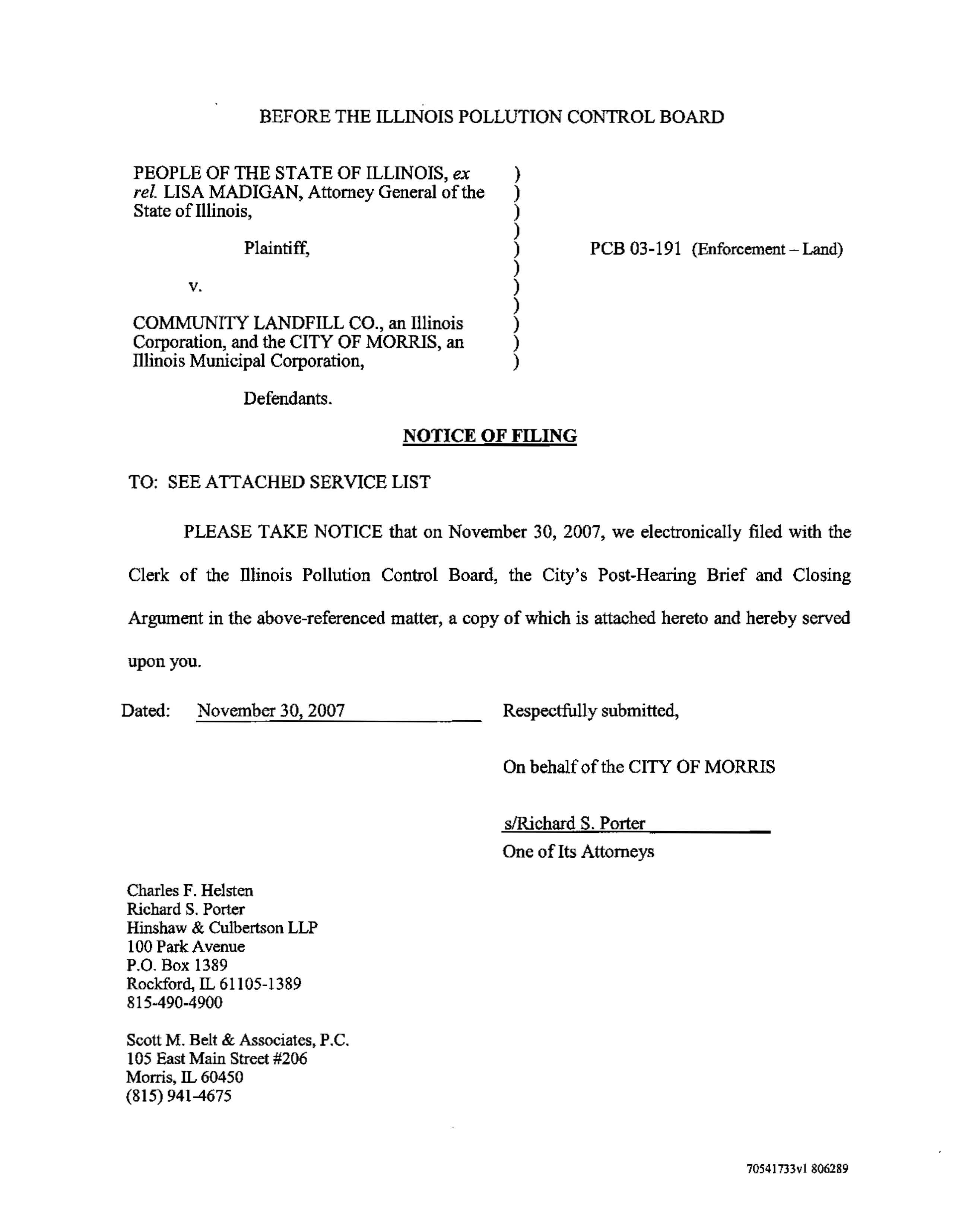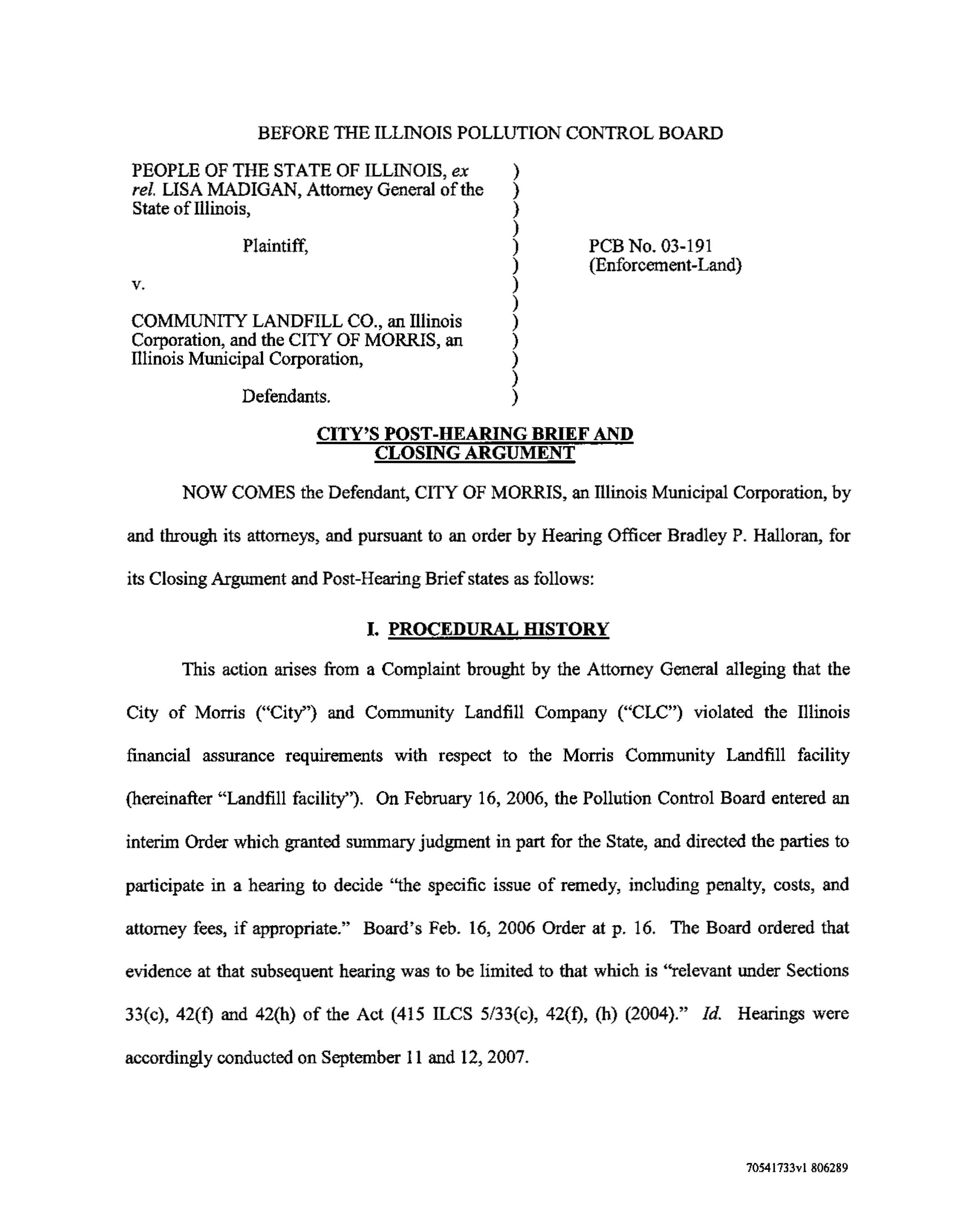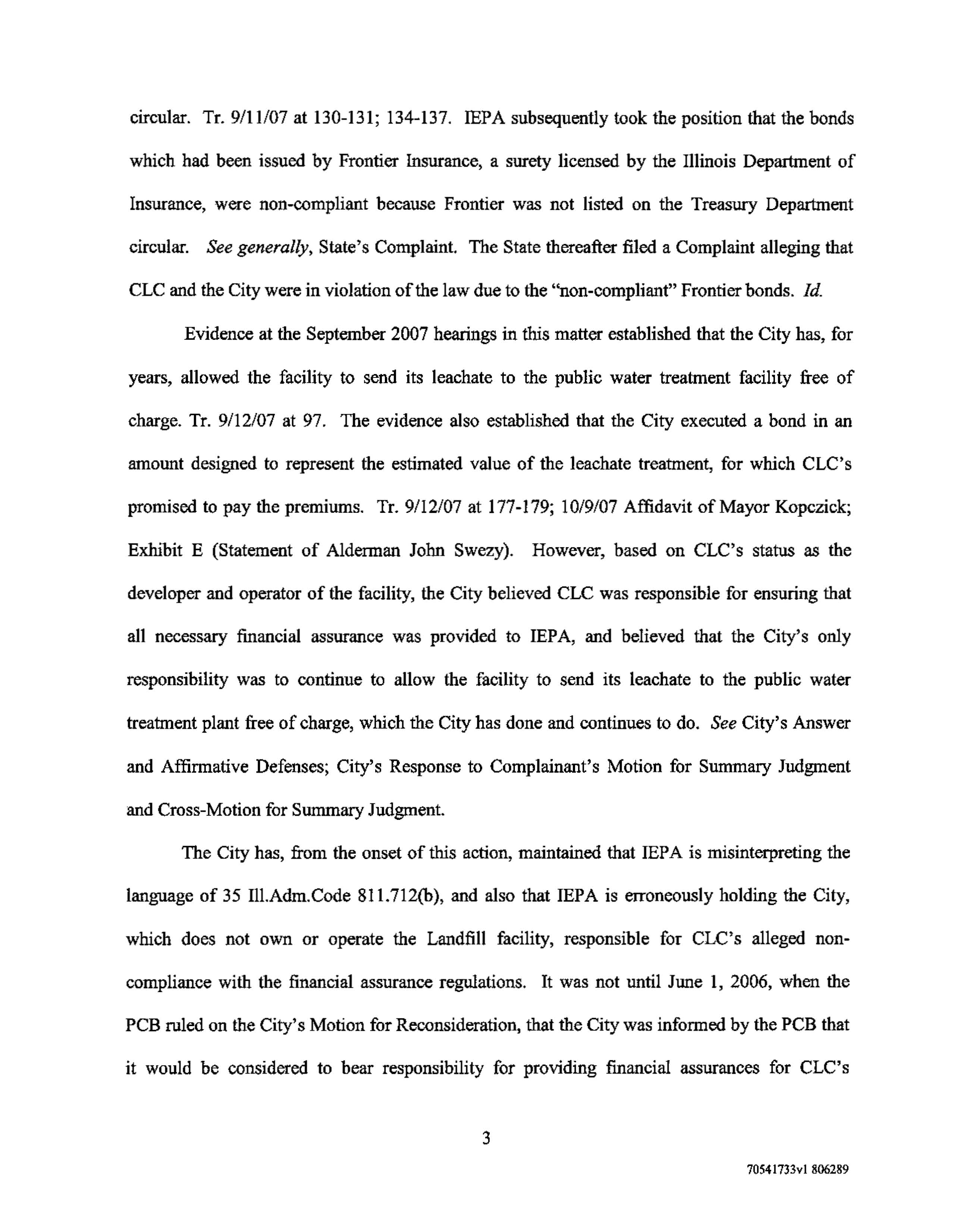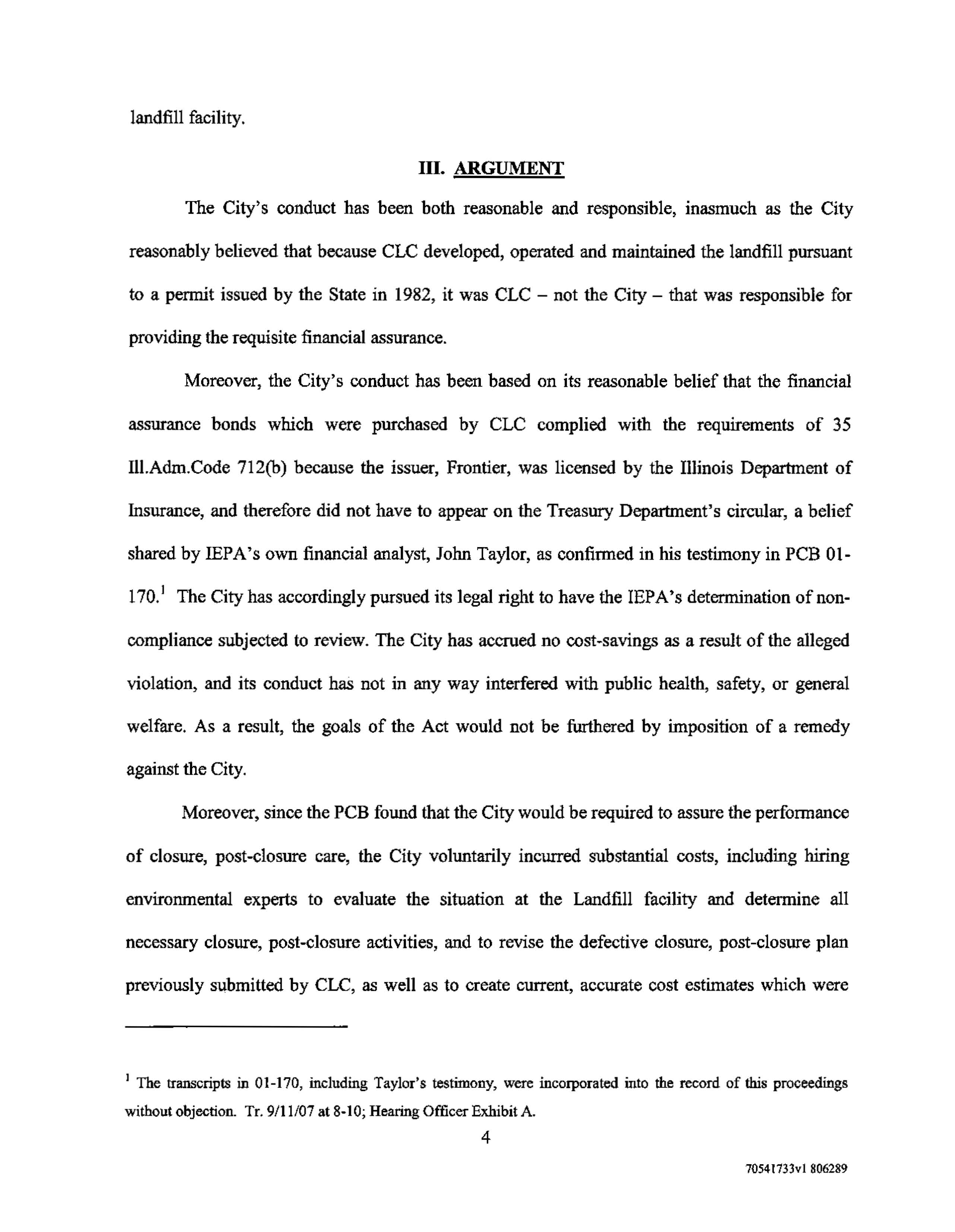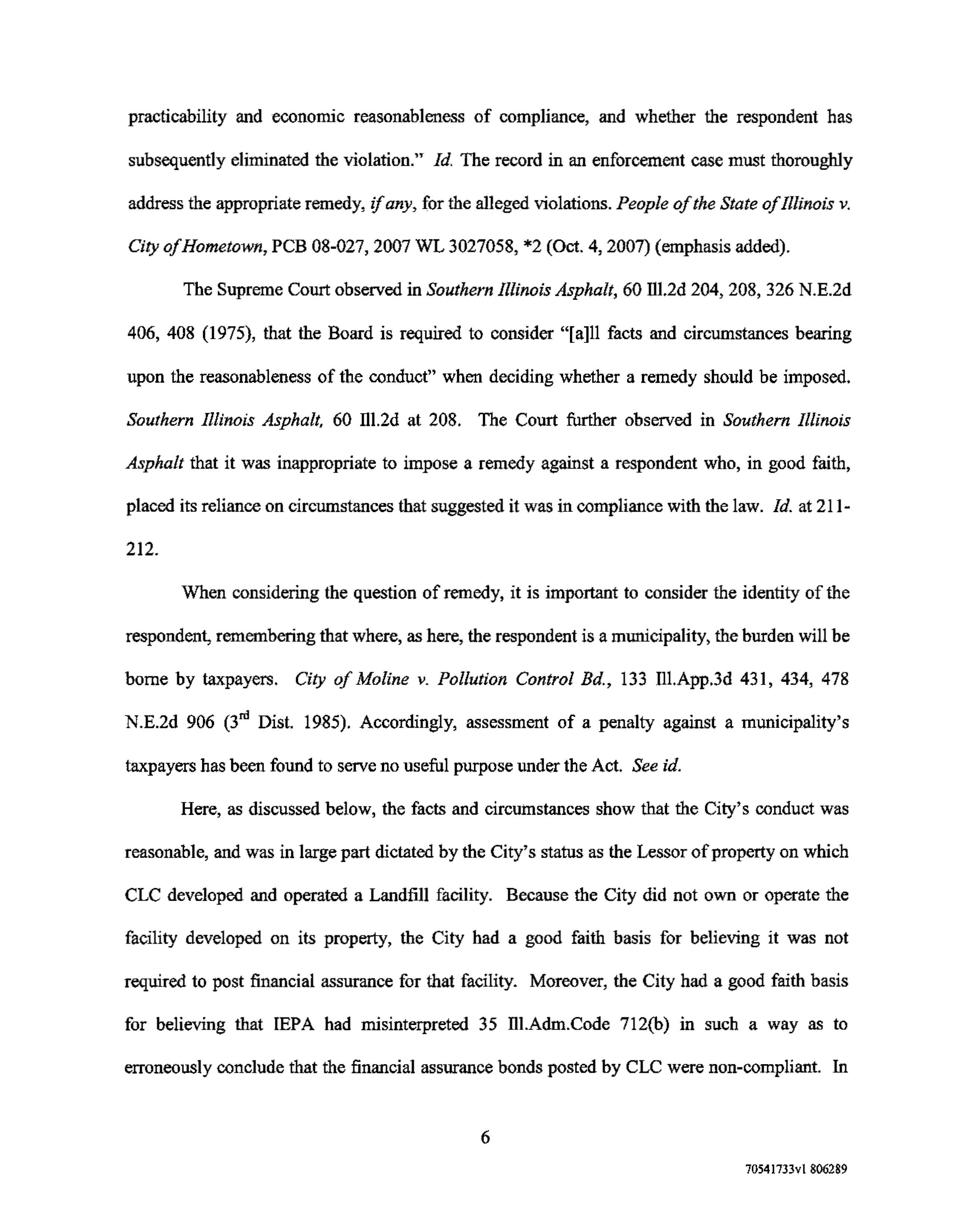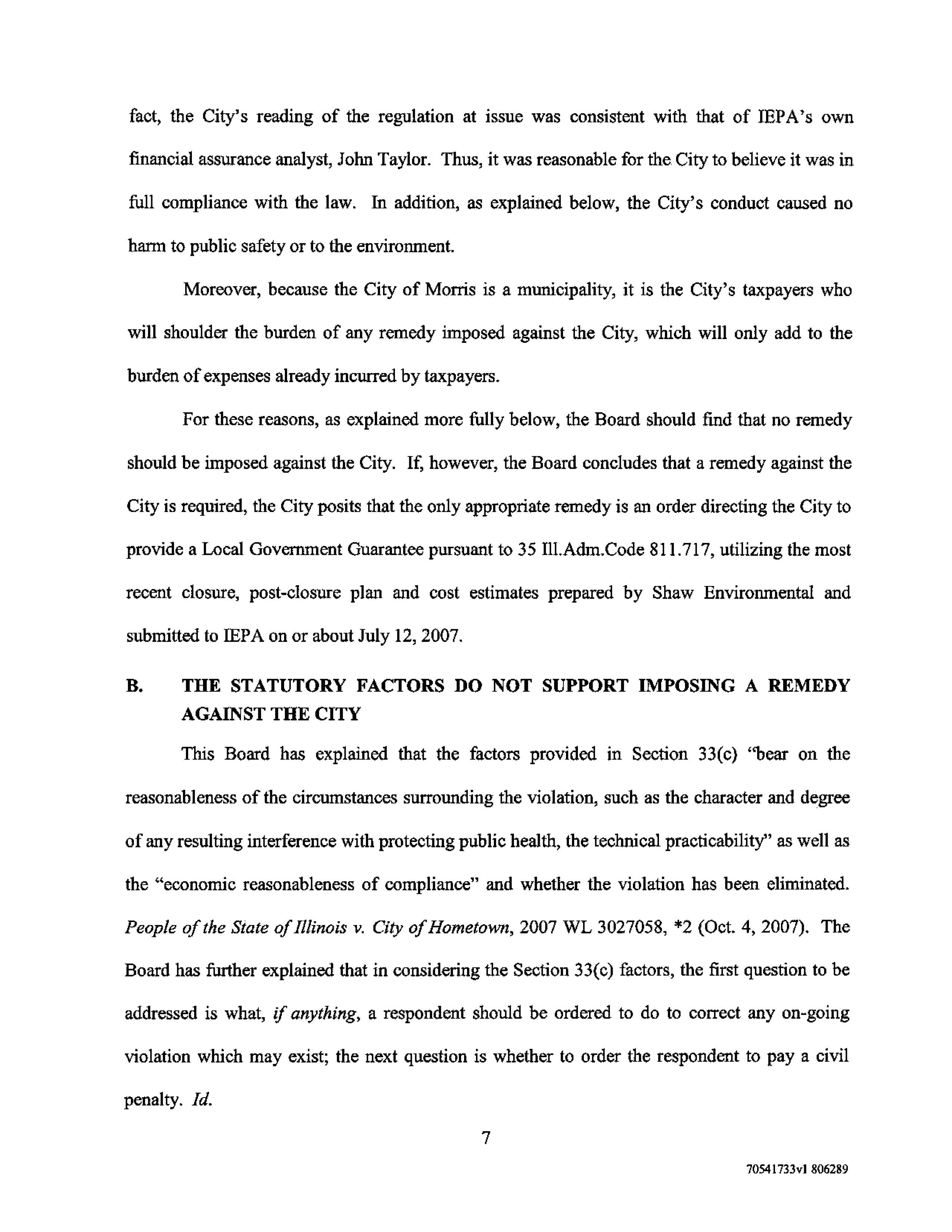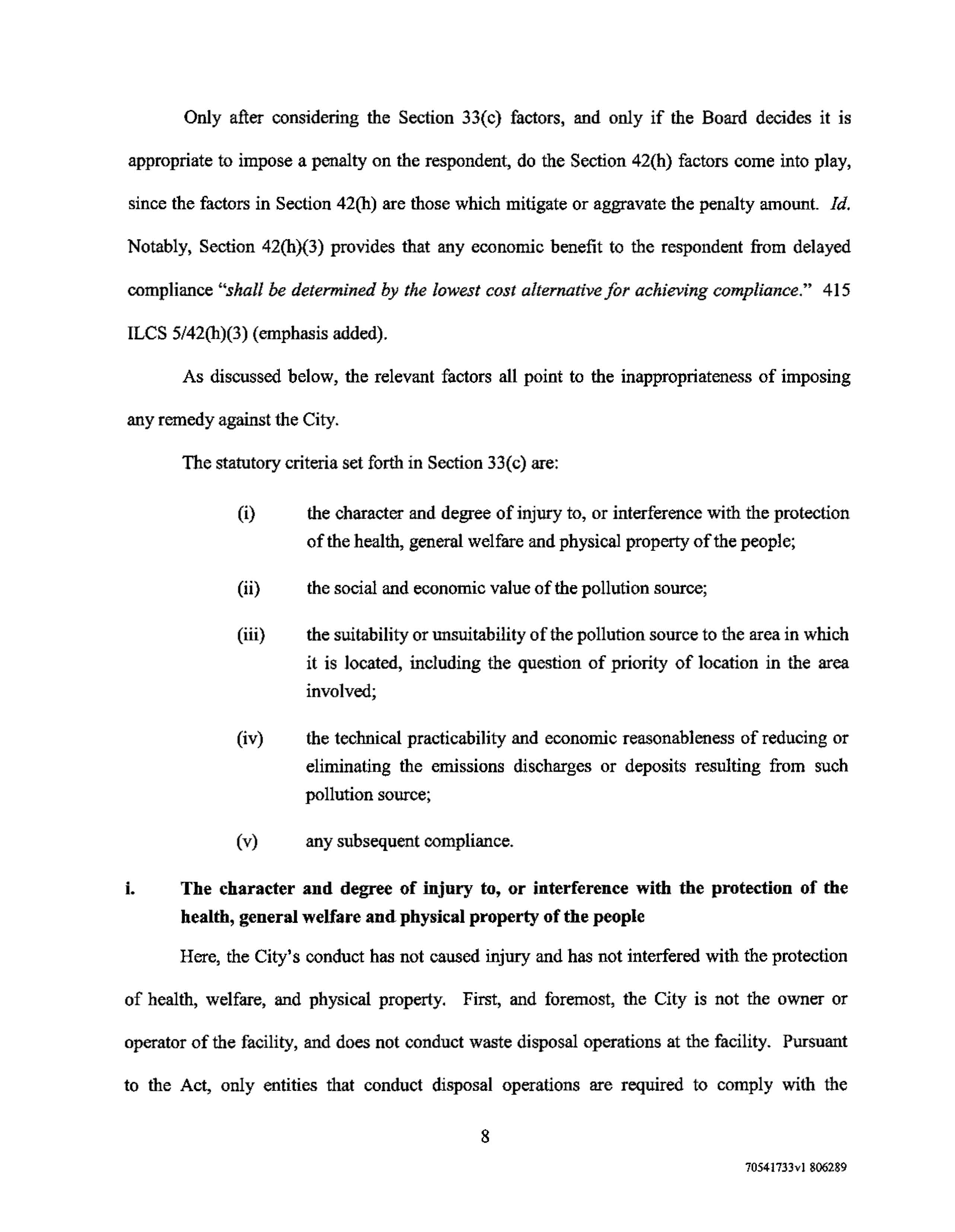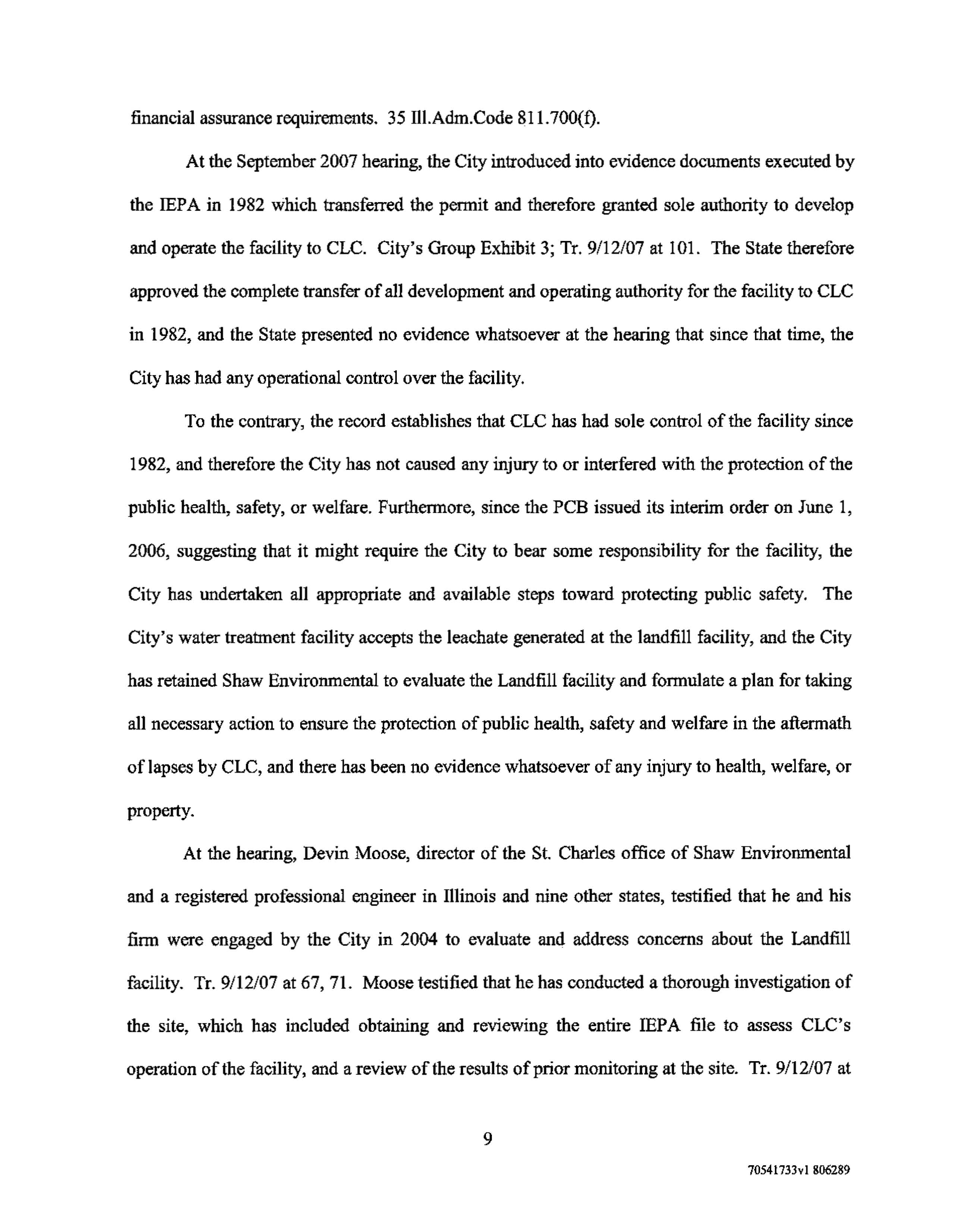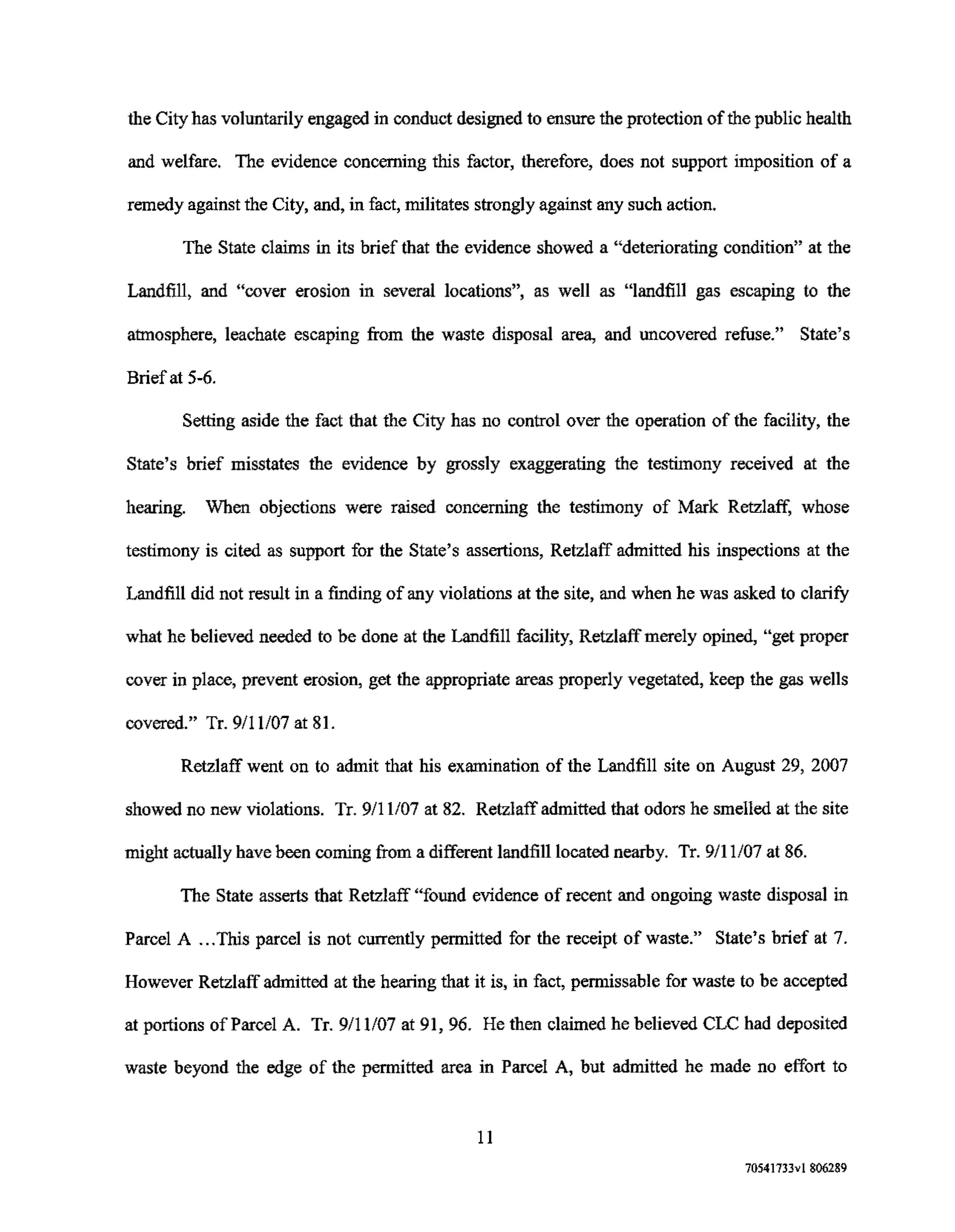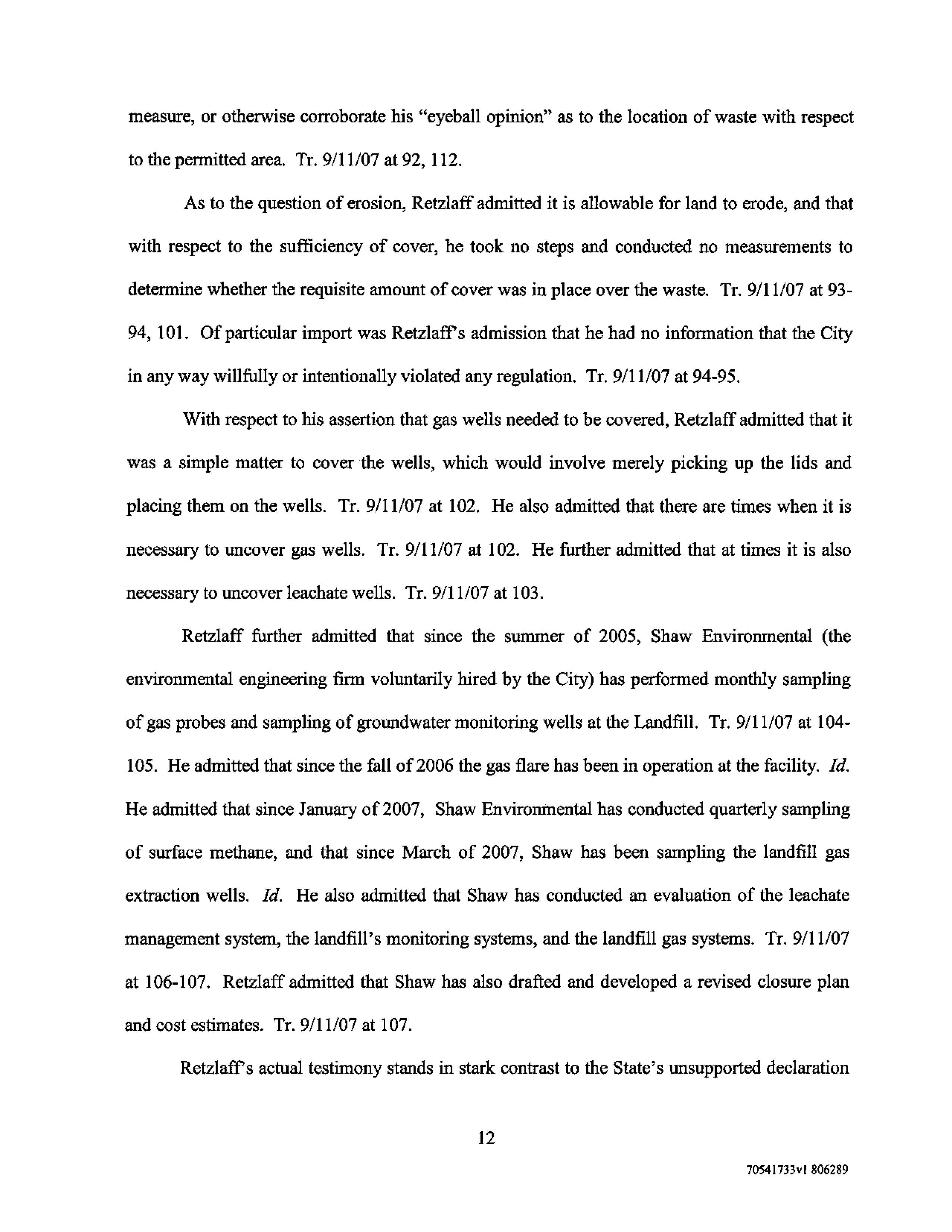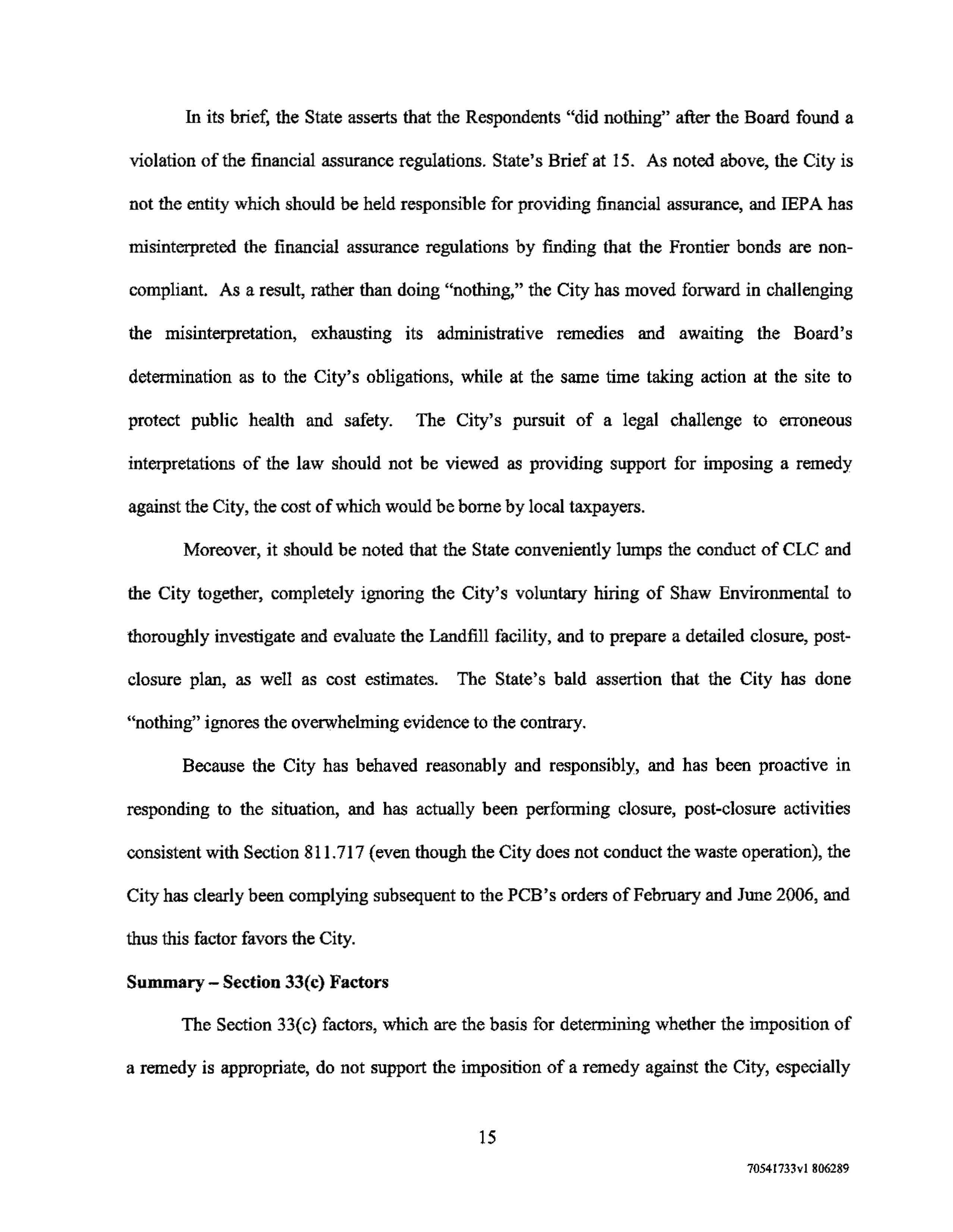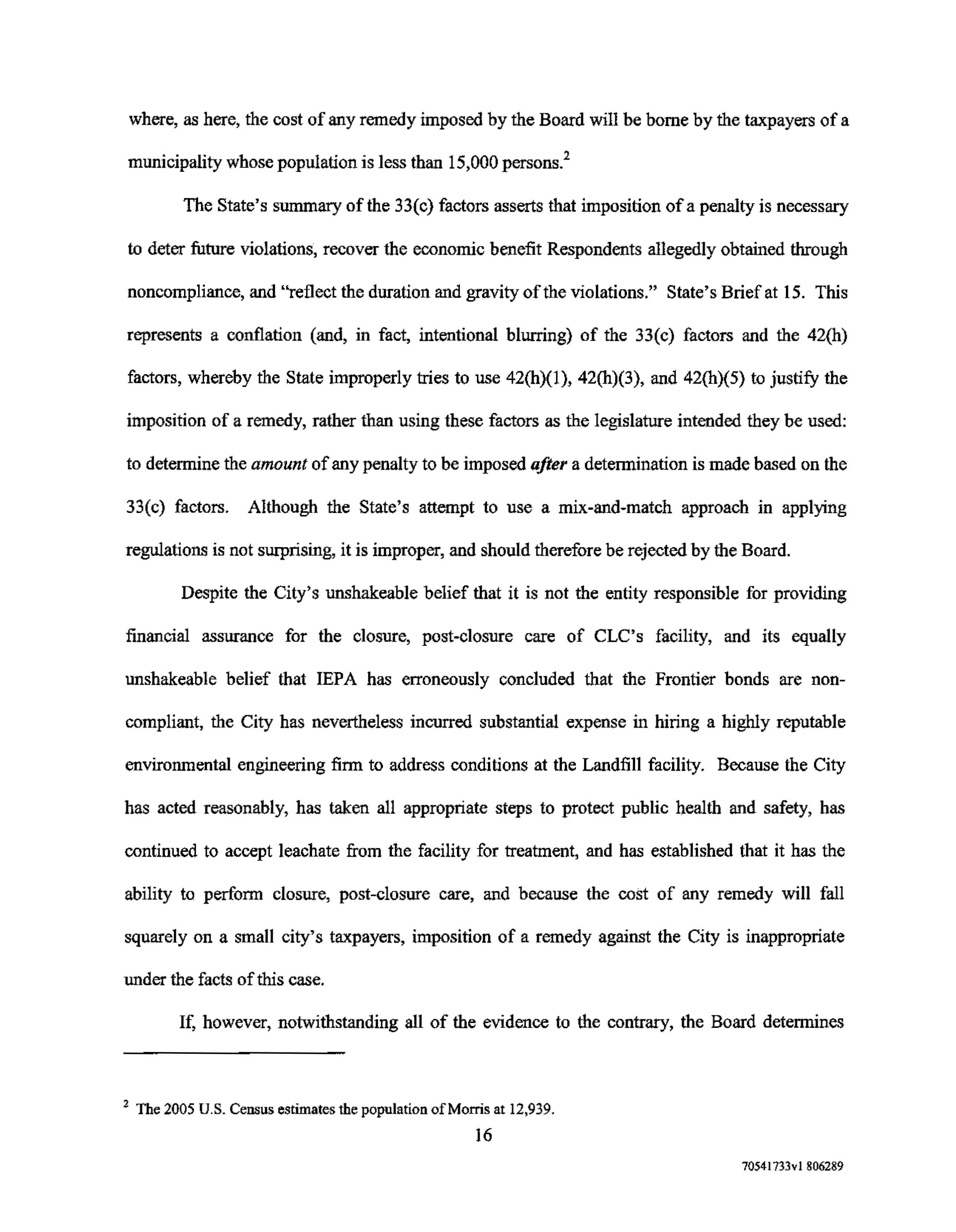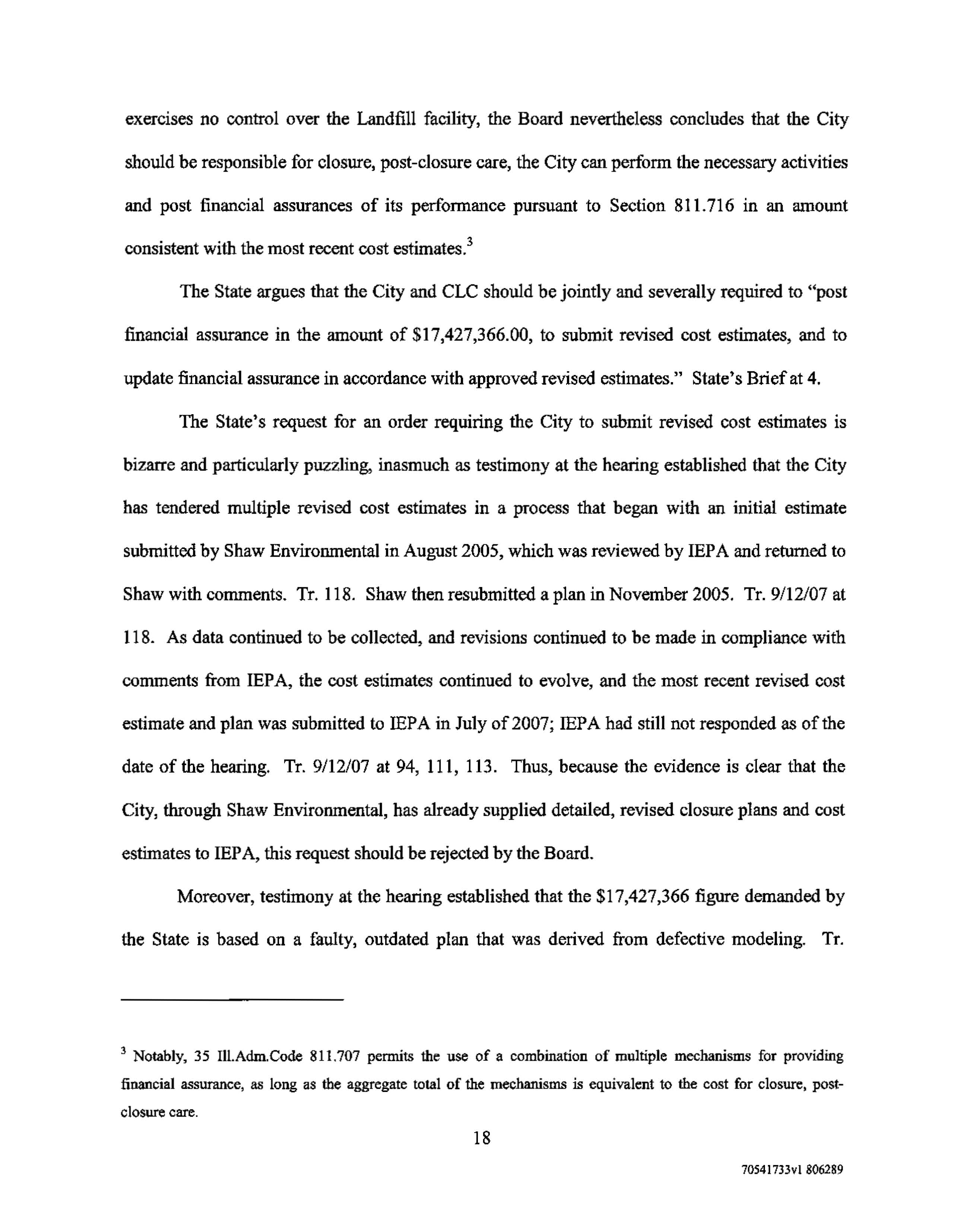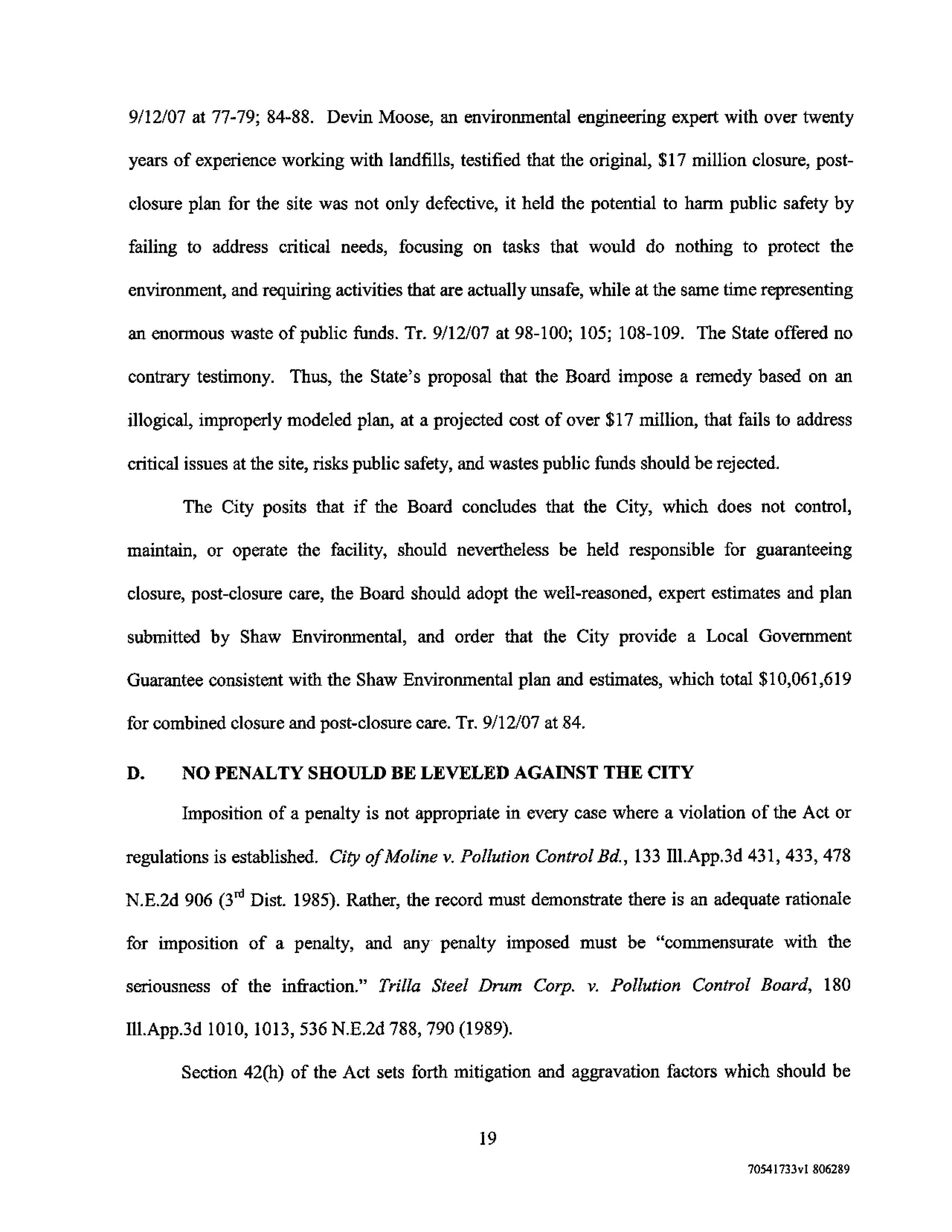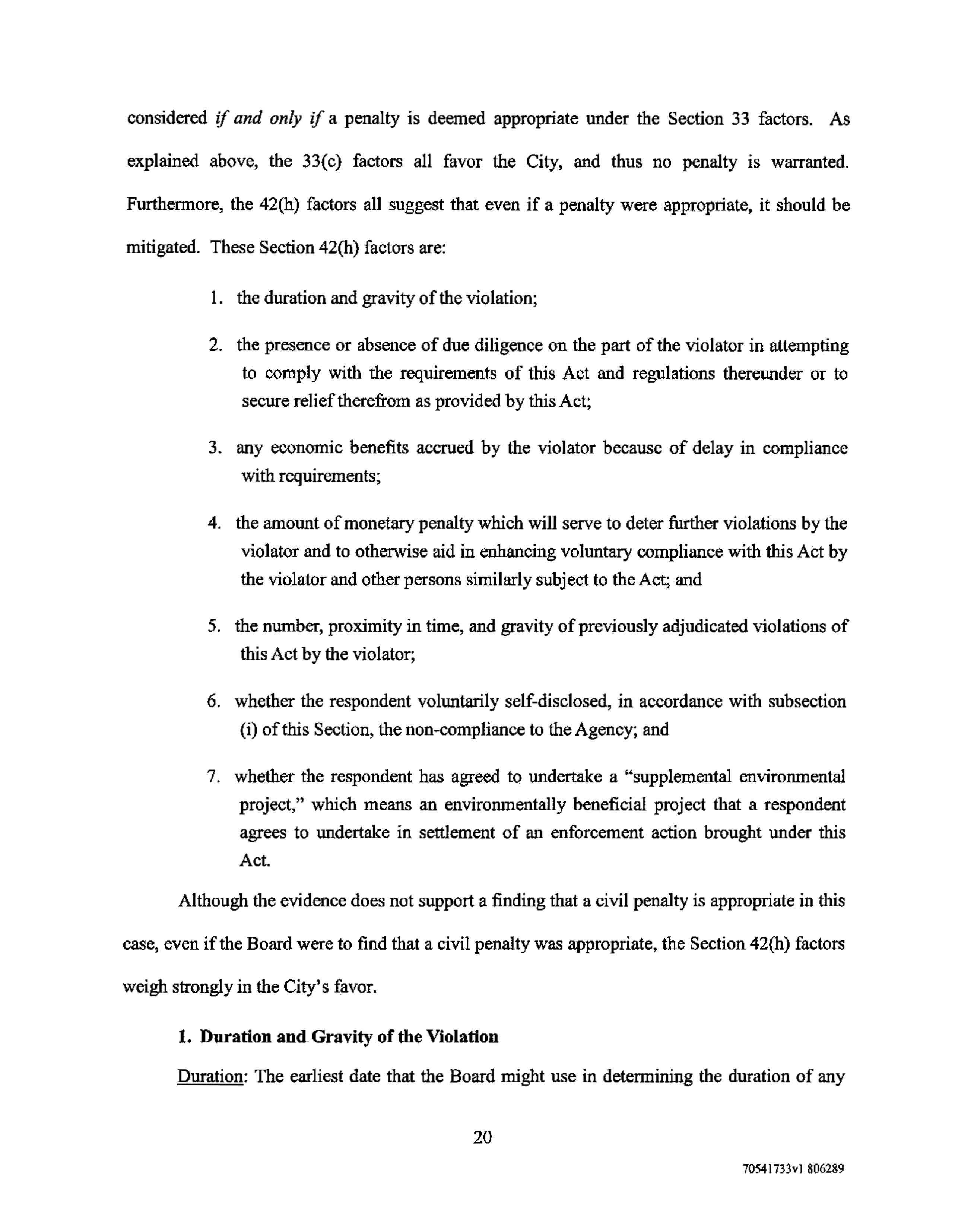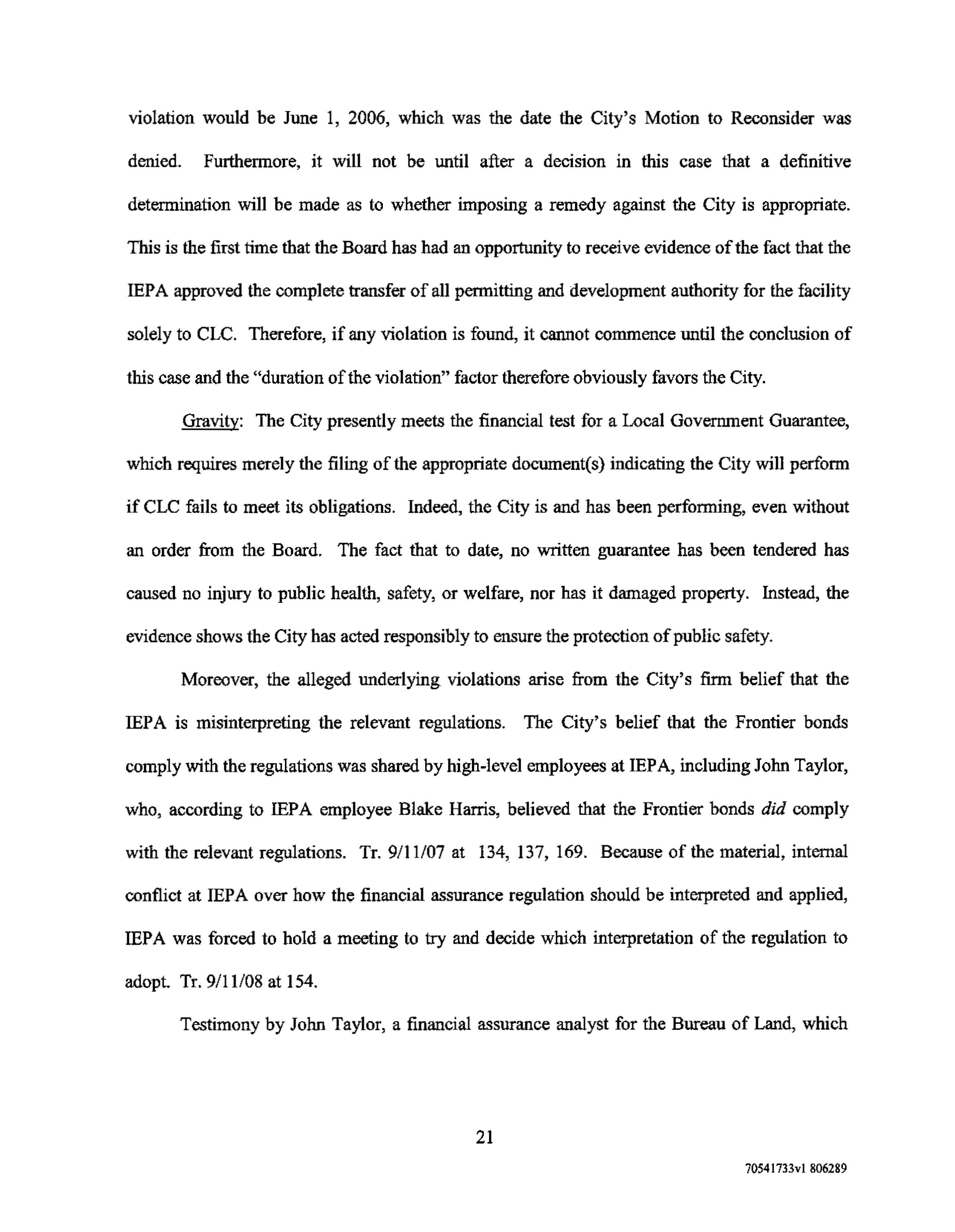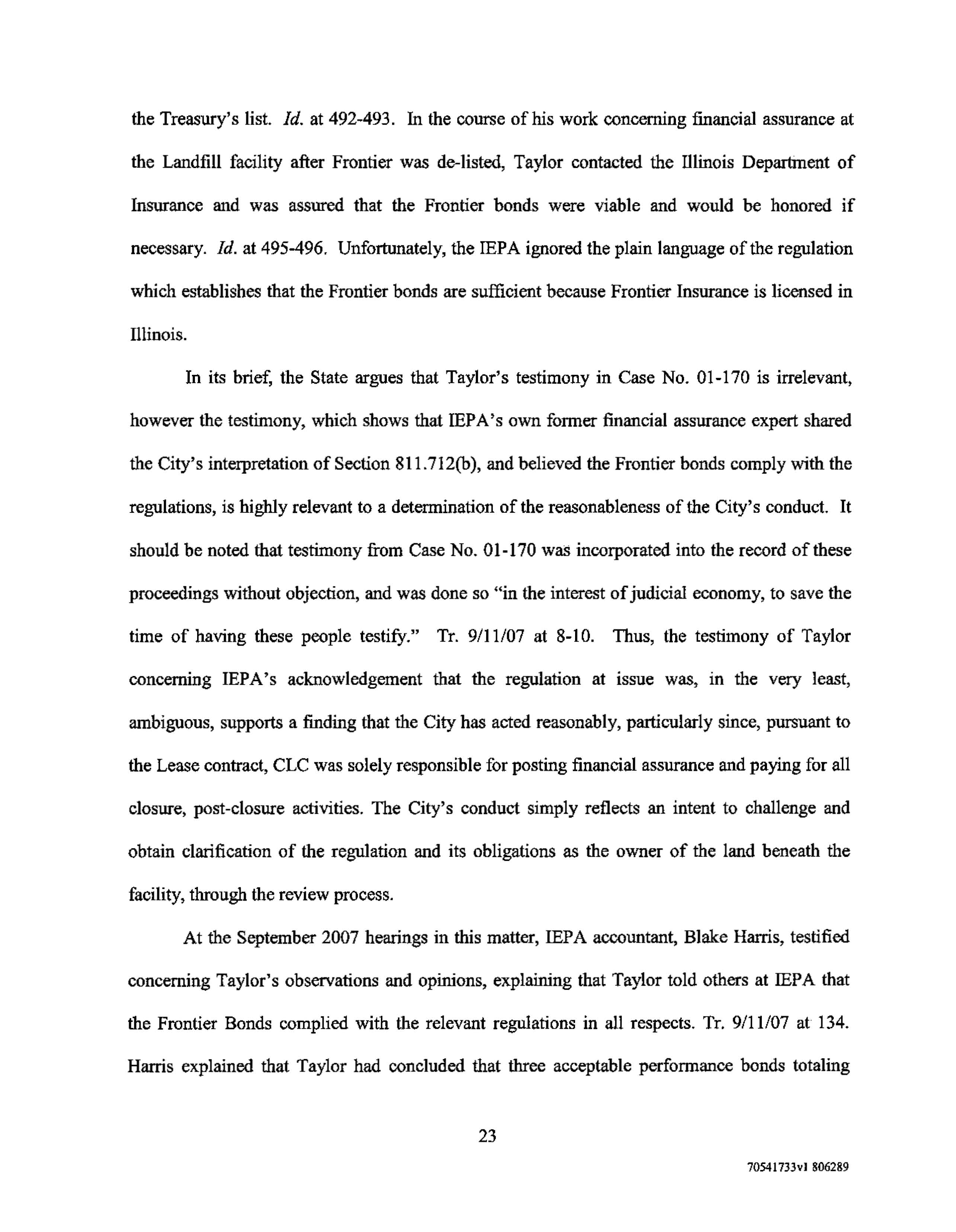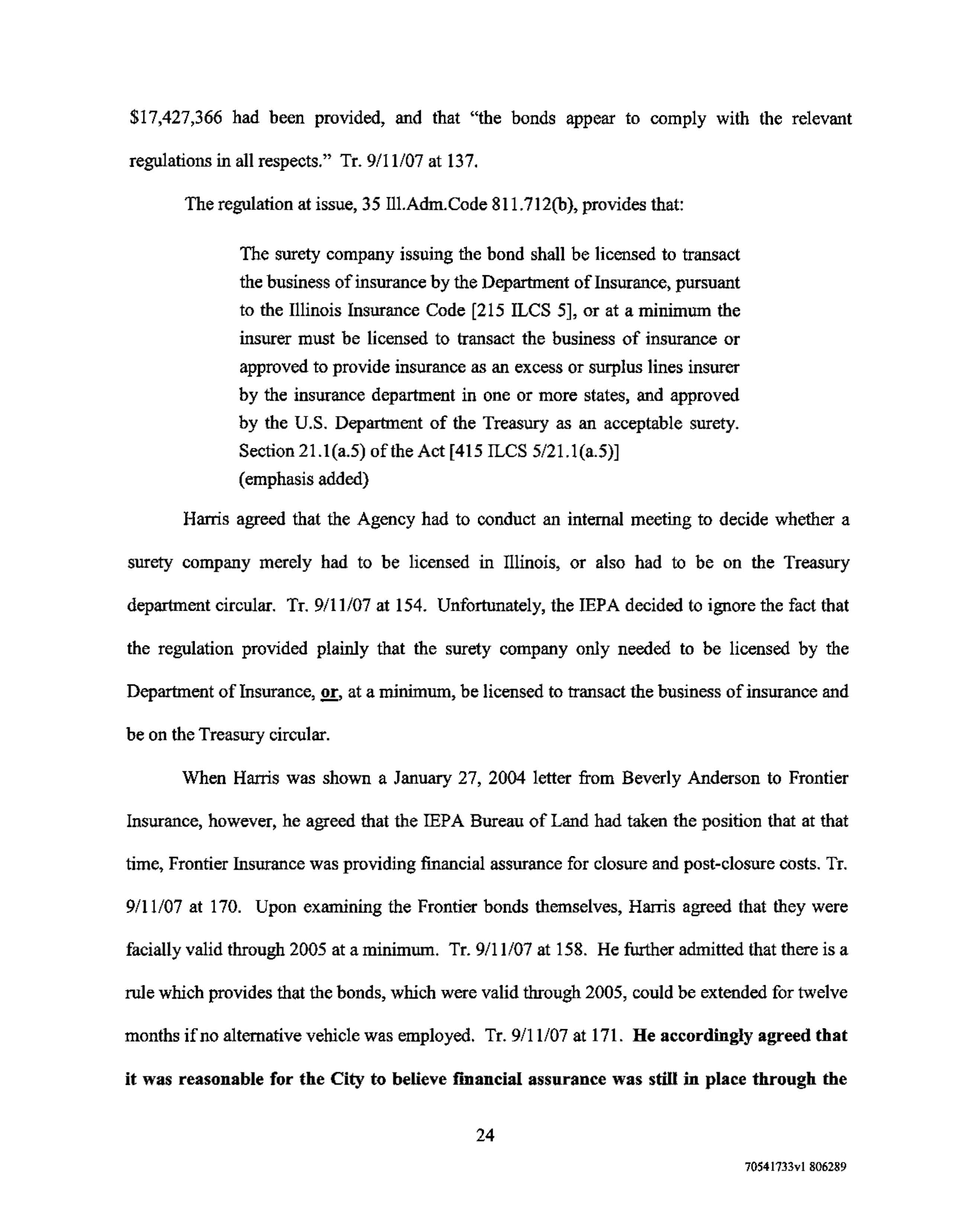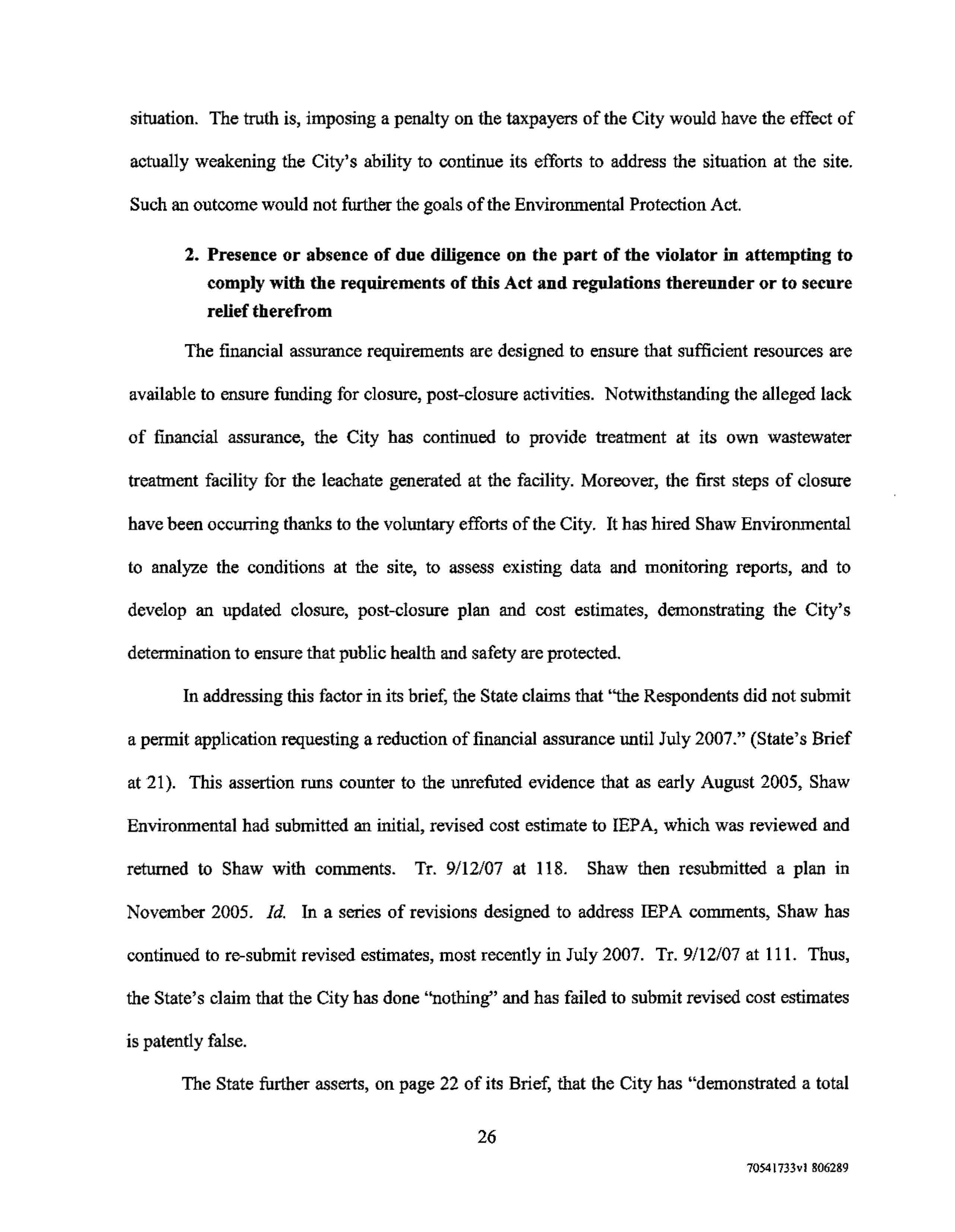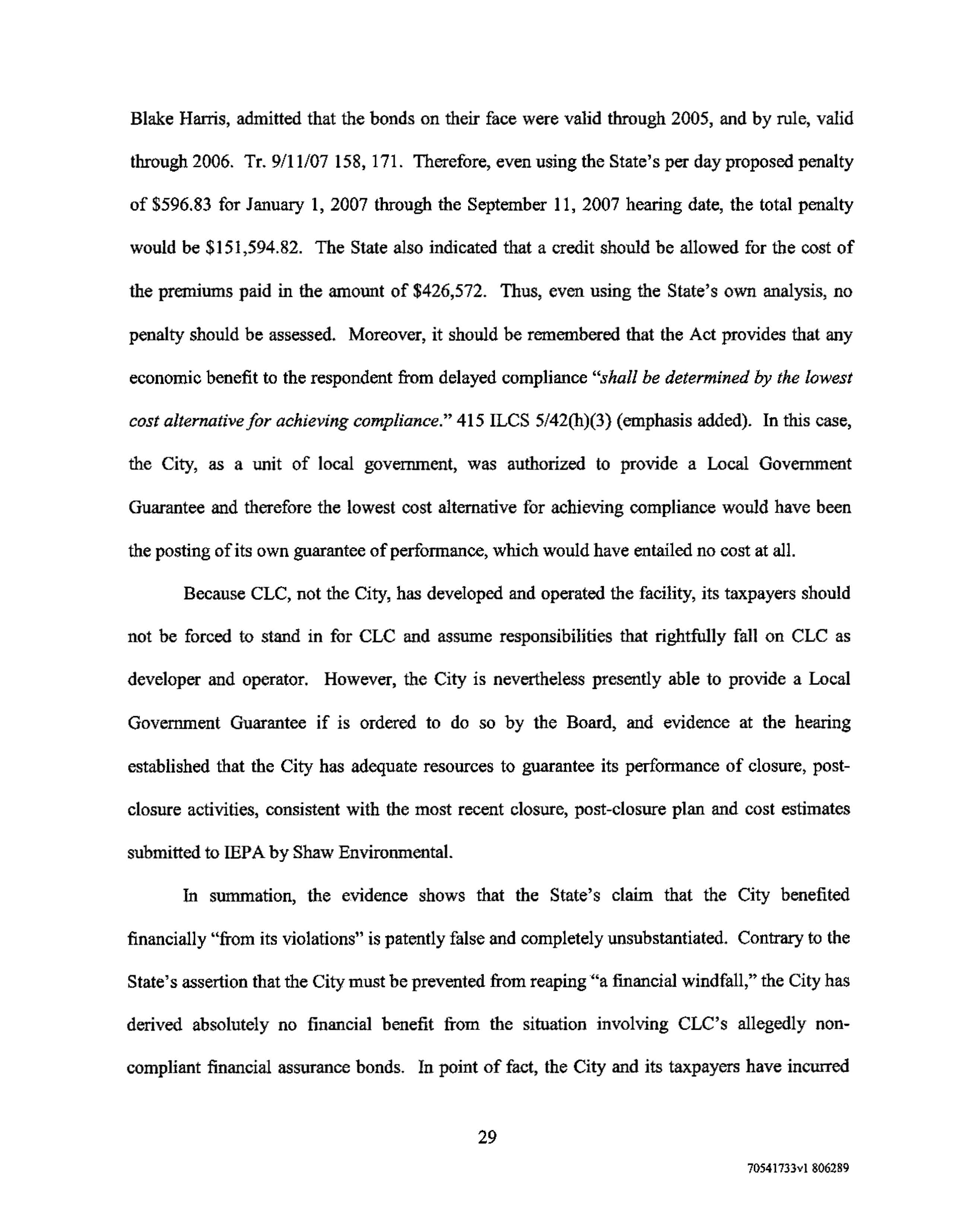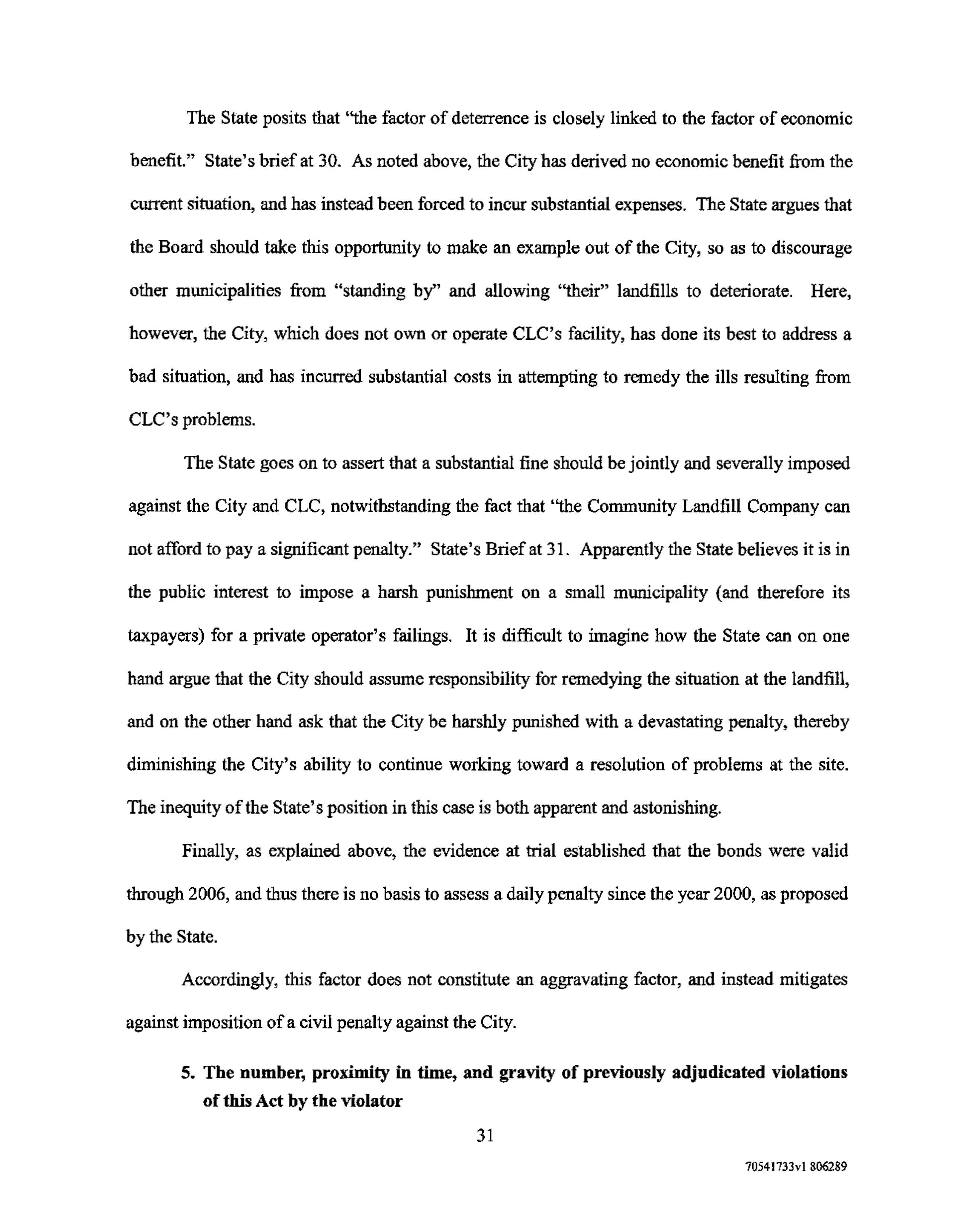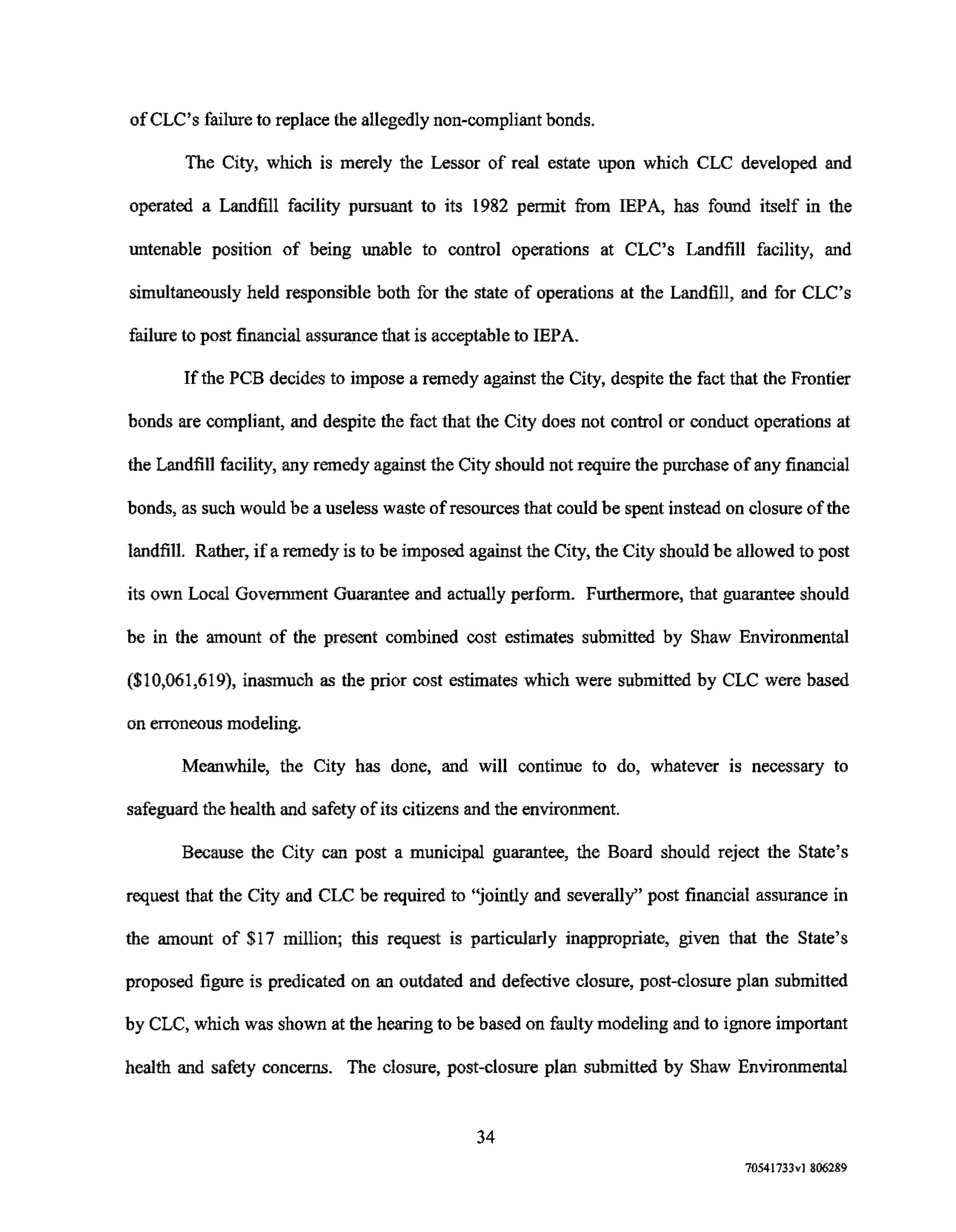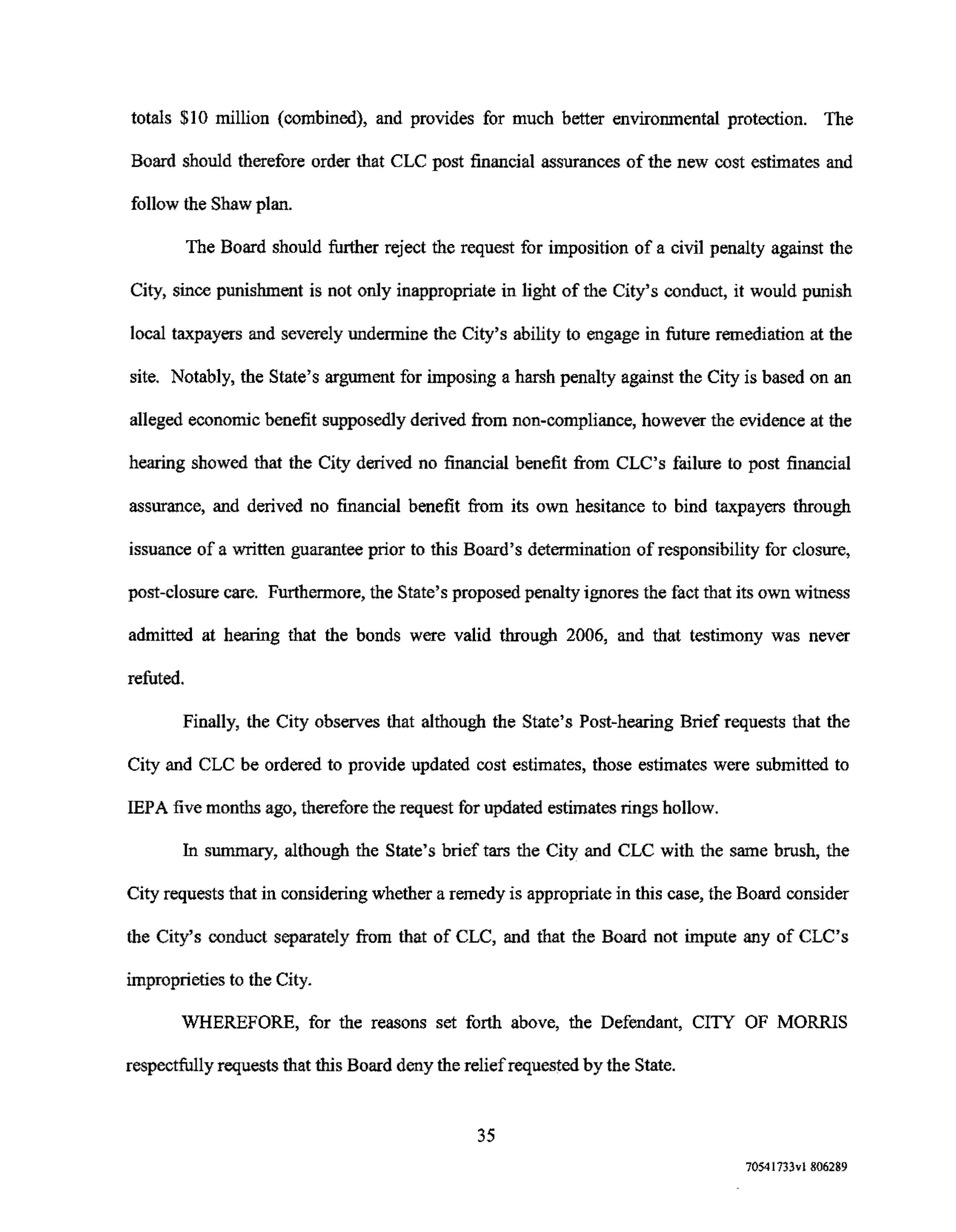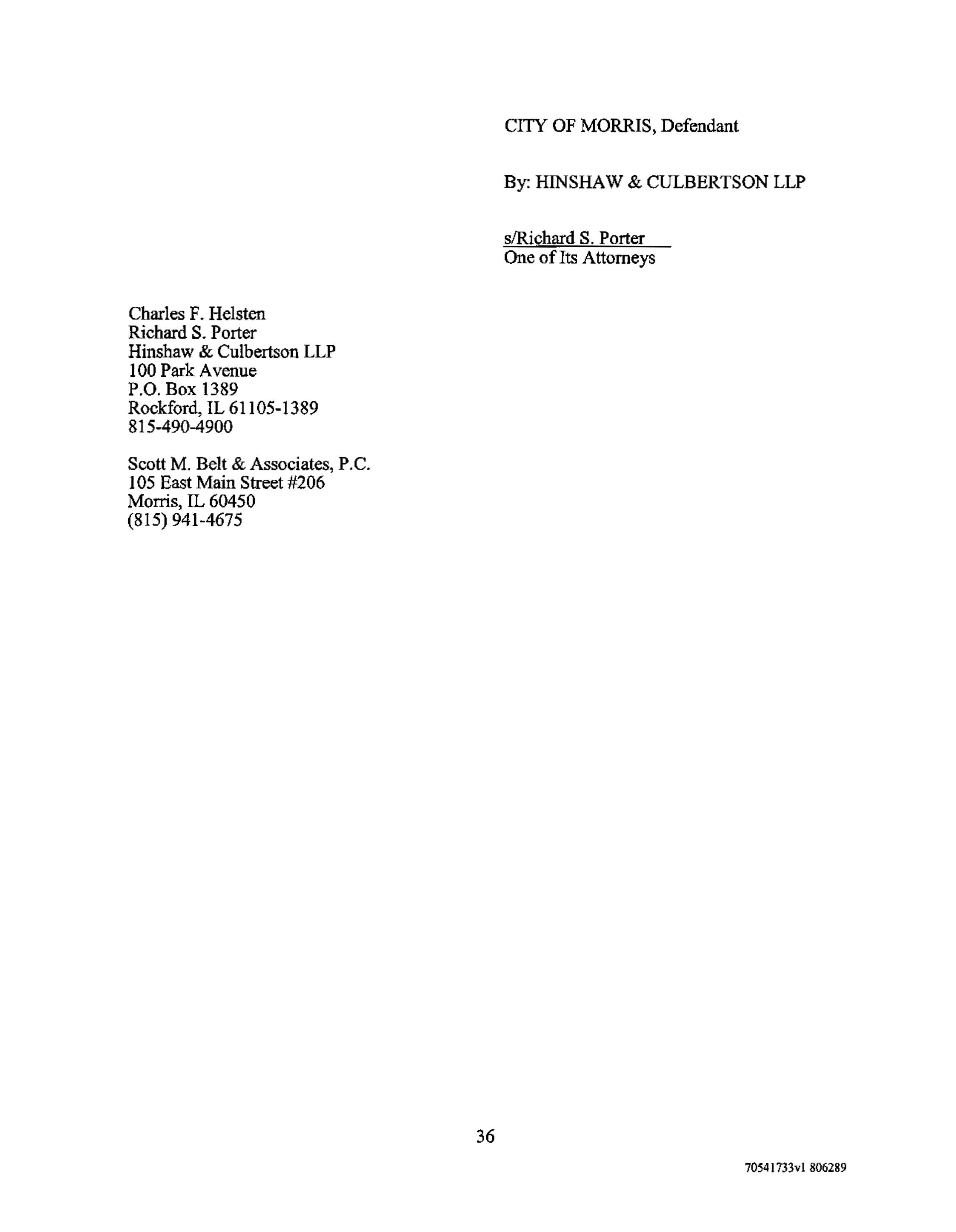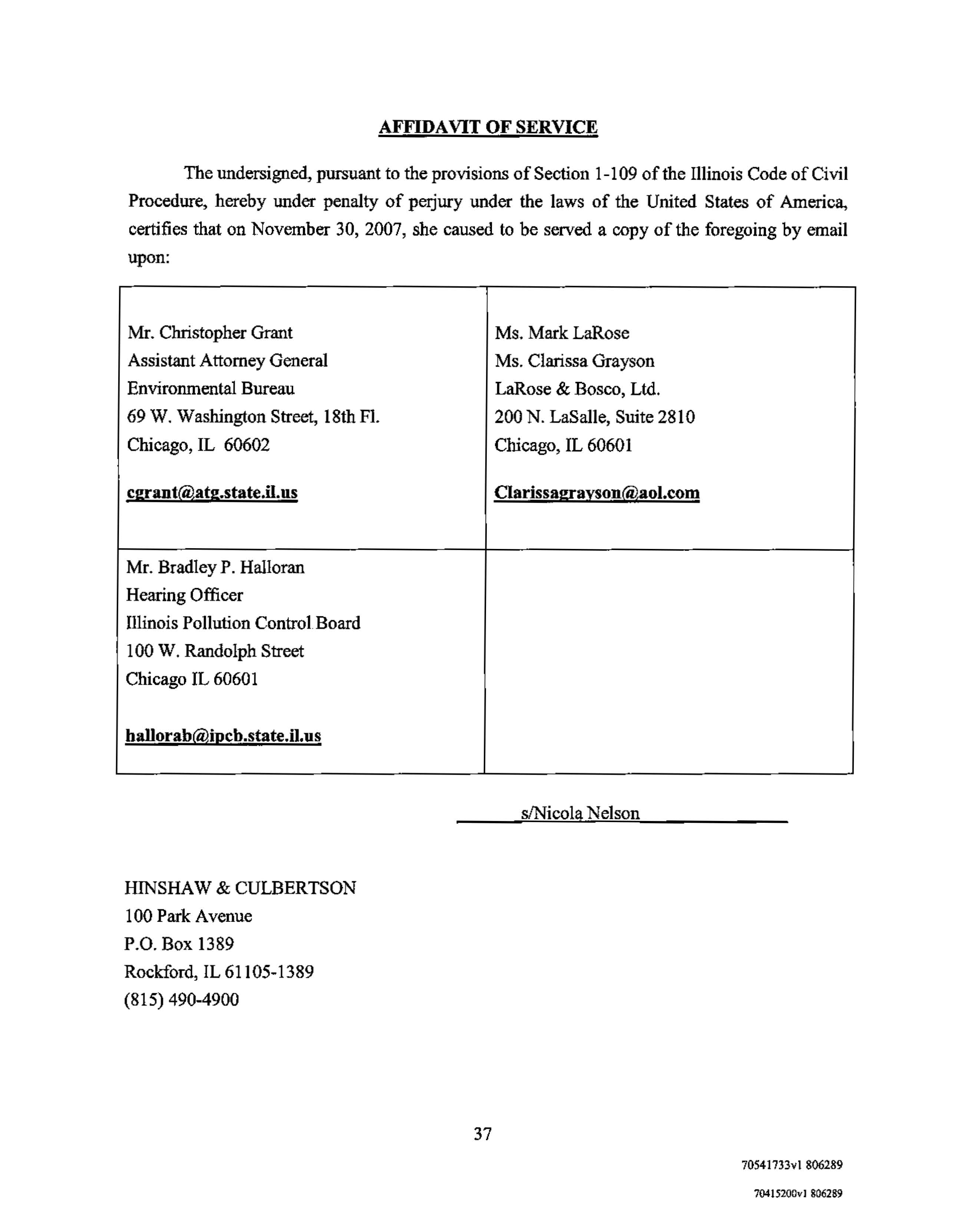BEFORE THE ILLINOIS POLLUTION CONTROL BOARD
PEOPLE OF THE STATE OF ILLINOIS,
ex
)
rei.
LISA MADIGAN, Attorney General ofthe
)
State
of Illinois,
)
)
Plaintiff,
)
)
v.
)
)
COMMUNITY LANDFILL CO., an Illinois
)
Corporation,
and the CITY OF MORRIS, an
)
llIinois Municipal Corporation,
)
Defendants.
NOTICE OF FILING
TO: SEE ATTACHED SERVICE LIST
PCB 03-191 (Enforcement-Land)
PLEASE TAKE NOTICE that on November 30, 2007, we electronically filed with the
Clerk of the Dlinois Pollution Control Board, the City's Post-Hearing Brief and Closing
Argument
in the above-referenced matter, a copy of which is attached hereto and hereby served
upon you.
Dated:
November 30, 2007
Charles F. Helsten
Richard
S. Porter
Hinshaw &
Culbertson LLP
100 Park Avenue
P.O. Box 1389
Rockford, IL 61105-1389
815~490-4900
Scott
M.
Belt
&
Associates,
P.e.
105 East Main Street #206
Morris, IL 60450
(815) 941-4675
Respectfully submitted,
On behalfofthe CITY OF MORRIS
slRichard S. Porter
One of Its Attorneys
70541733vl 806289
Electronic Filing: Received, Clerk's Office, November 30, 2007
PCB No. 03-191
(Enforcement-Land)
BEFORE THE ILLINOIS POLLUTION CONTROL BOARD
PEOPLE OF THE STATE OF ILLINOIS,
ex
)
reZ.
LISA MADIGAN, Attorney General ofthe
)
State
of Illinois,
)
)
Plaintiff,
)
)
v.
)
)
COMMUNITY LANDFILL CO., an Illinois
)
Corporation, and the CITY OF MORRIS, an
)
lllinois Municipal Corporation,
)
)
Defendants.
)
CITY'S POST-HEARING BRIEF AND
CLOSING ARGUMENT
NOW COMES the Defendant, CITY OF MORRIS, an Illinois Municipal Corporation, by
and through its attorneys, and pursuant to an order by Hearing Officer Bradley P. Halloran, for
its Closing Argument and Post-Hearing
Brief states as follows:
I. PROCEDURAL mSTORY
This action arises from a Complaint brought by the Attorney General alleging that the
City
of Morris ("City") and Community Landfill Company ("CLC") violated the Illinois
financial assurance requirements
with respect to the Morris Community Landfill facility
(hereinafter "Landfill facility").
On February 16, 2006, the Pollution Control Board entered an
interim Order which granted summary judgment
in part for the State, and directed the parties to
participate
in
a hearing to decide ''thespecific issue of remedy, including penalty, costs, and
attorney fees,
if appropriate." Board's Feb. 16, 2006 Order at p. 16. The Board ordered that
evidence at that subsequent hearing was to
be limited to that which is "relevant under Sections
33(c), 42(t) and 42(h)
of the Act (415 ILCS 5/33(c), 42(t), (h) (2004)."
Id.
Hearings were
accordingly conducted
on September 11 and 12,2007.
70541733v1806289
Electronic Filing: Received, Clerk's Office, November 30, 2007
II. FACTUAL BACKGROUND
The issue, with respect to the City, is whether a remedy should be imposed against the
City for its conduct relating
to the violations alleged in the State's Complaint, and if so, what
remedy is appropriate.
By necessity, therefore, the Board must consider the reasonableness of
the City'sconduct under the circumstances.
Evidence at the hearing revealed that in 1982, the City transferred ownership and control
of the Morris Community Landfill facility to CLC, and that the State approved the conveyance,
transferring the State permit which authorized development, operation and control
of the facility
to CLC. Hearing Exh. 3(b); Tr. 9/12/07 at 101-102.
At all relevant times thereafter, the City believed, in good faith, that CLC,
as the
developer and operator
of the facility, was the entity responsible for posting the financial
assurance required
by 35 TIl.Adm.Code 700. Tr. 9/12/07 at 101-102; City's Answer and
Affinnative Defenses; City's Response
to Complainant's Motion for Summary Judgment and
Cross-Motion for Summary Judgment. CLC procured financial assurance
by acquiring bonds
from Frontier Insurance Company. These bonds were reviewed and accepted by the IEPA from
1996
to
2000. Hearing Officer's Exhibit A: Tr. in PCB 01-170 at 478-478, 481-484, 489-492.
Frontier Insurance company at all relevant times was licensed
by the Illinois Department of
Insurance, however on or about June 1, 2000, Frontier Insurance was removed from the Treasury
Department's circular.
Id.
Even the State's own witness has acknowledged it was reasonable for
the City
to
believe the bonds were effective through 2006. Tr. 9/11107 at 171-172.
A disagreement developed among personnel at IEPA concerning the interpretation
of 35
Ill.Adm.Code 811.712(b), and whether that regulation mandated that sureties who are licensed
by the Illinois Department of Insurance must also be listed on the Treasury Departmenfs
2
70541733vl 806289
Electronic Filing: Received, Clerk's Office, November 30, 2007
circular. Tr. 9/11/07 at 130-131; 134-137. !EPA subsequently took the position that the bonds
which had been issued by Frontier Insurance, a surety licensed by the Illinois Department of
Insurance, were non-compliant because Frontier was not listed on the Treasury Department
circular.
See generally,
State's Complaint. The State thereafter filed a Complaint alleging that
CLC and the City were in violation ofthe law due to the ''non-compliant''Frontier bonds.
ld.
Evidence at the September 2007 hearings in this matter established that the City has, for
years, allowed the facility to send its leachate to the public water treatment facility free of
charge. Tr. 9/12/07 at 97. The evidence also established that the City executed a bond in an
amount designed to represent the estimated value of the leachate treatment, for which CLC's
promised to pay the premiums. Tr.
9/12/07
at 177-179;
1019107
Affidavit of Mayor Kopczick;
Exhibit E (Statement of Alderman John Swezy). However, based on CLC's status as the
developer and operator of the facility, the City believed CLC was responsible for ensuring that
all necessary financial assurance was provided to IEPA, and believed that the City's only
responsibility was to continue to allow the facility to send its leachate to the public water
treatment plant free of charge, which the City has done and continues to do.
See
City's Answer
and Affirmative Defenses; City's Response to Complainant's Motion for Summary Judgment
and Cross-Motion for Swnmary Judgment.
The City has, from the onset of this action, maintained that IEPA is misinterpreting the
language of 35 IlLAdm.Code 811.712(b), and also that IEPA is erroneously holding the City,
which does not own or operate the Landfill facility, responsible for CLC's alleged non-
compliance with the financial assurance regulations.
It
was not until June 1, 2006, when the
PCB ruled on the City'sMotion for Reconsideration, that the City was informed by the PCB that
it would be considered to bear responsibility for providing financial assurances for CLC's
3
70541733vl 806289
Electronic Filing: Received, Clerk's Office, November 30, 2007
landfill facility.
III. ARGUMENT
The City's conduct has been both reasonable and responsible, inasmuch as the City
reasonably believed that because CLC developed, operated and maintained the landfill pursuant
to a permit issued by the State in 1982, it was CLC - not the City - that was responsible for
providing the requisite financial assurance.
Moreover, the City's conduct has been based on its reasonable belief that the financial
assurance bonds which were purchased by CLC complied with the requirements of 35
Ill.Adm.Code 712(b) because the issuer, Frontier, was licensed by the Illinois Department of
Insurance, and therefore did not have to appear on the Treasury Department's circular, a belief
shared by !EPA'sown financial analyst, John Taylor, as confioned in his testimony in PCB 01-
170.
1
The City has accordingly pursued its legal right to have the IEPA's detennination of non-
compliance subjected to review. The City has accrued no cost-savings as a result of the alleged
violation, and its conduct haS not in any way interfered
with
public health, safety, or general
welfare. As a result, the goals of the Act would not be furthered by imposition of a remedy
against the City.
Moreover, since the PCB found that the City would be required to assure the perfonnance
of closure, post-closure care, the City voluntarily incurred substantial costs, including hiring
environmental experts to evaluate the situation at the Landfill facility and detennine all
necessary closure, post-closure activities, and to revise the defective closure, post-closure plan
previously submitted by CLC, as well as to create current, accurate cost estimates which were
J
The transcripts in 01-170, including Taylor's testimony, were incorporated into the record of this proceedings
without objection. Tr. 9/11/07 at 8-10; Hearing Officer Exhibit
A.
4
70541733vl 806289
Electronic Filing: Received, Clerk's Office, November 30, 2007
submitted to IEPA approximately six months ago. Tr. 9/12/07 at 94, 111-113, 118;
see also
testimony of IEPA employee Christine Roque, Tr.
9111/07
at 229, 231.
It
is the City'staxpayers
who have been forced to shoulder these expenses, and it is those same taxpayers who will
shoulder the burden
if a remedy is imposed against the City by the Board, essentially standing in
as
the scapegoat for CLC.
For these reasons, no remedy should
be imposed against the City. However, if the Board
feels compelled
to impose a remedy against the City, and is determined that the City must act as
the surrogate for CLC, the City posits that the only remedy against the City which should be
considered is an order mandating that the City post
a
Local Government Guarantee pursuant to
35
Ill.Adm.Code 811.717, in an amount consistent with the current cost estimates, as prepared by
Shaw Environmental and submitted
to IEPA in July 2007.
A. NO
REMEDY SHOULD BE IMPOSED AGAINST THE CITY
The Board's February 16, 2006 order directed the parties to engage in a hearing "on the
specific issue
of remedy, including penalty, costs, and attorney fees,
if
appropriate."
Under the
facts
of this case, as established by the evidence adduced at the hearing, it is not appropriate to
impose any remedy against the City.
When considering the question
of remedy, "the Board considers the Section 33(c) factors
in determining, first, what
to order the respondent to do to correct an on-going violation, if any,
and, second, whether to order the respondent
to pay a civil penalty."
People of the State of
Illinois v. Gateway Bobcat of Herberer Equipment Co.,
PCB 08-029, 2007 WL 3153603, *2
(October 18, 2007). This Board opined in
Gateway Bobcat
that "the factors provided in Section
33(c) bear on the reasonableness
of the circumstances surrounding the violation, such as the
character and degree
of any resulting interference with protecting public health, the technical
5
70541733v1806289
Electronic Filing: Received, Clerk's Office, November 30, 2007
practicability and economic reasonableness of compliance, and whether the respondent has
subsequently eliminated the violation."
Id.
The record
in
an enforcement
case
must thoroughly
address the appropriate remedy,
if
any,
for the alleged violations.
People ofthe State ofIllinois
v.
City ofHometown,
PCB 08-027, 2007 WL 3027058, *2 (Oct. 4, 2007) (emphasis added).
The Supreme Court observed in
Southern Illinois Asphalt,
60 Dl.2d 204,208,326 N.E.2d
406, 408 (1975), that the Board is required to consider "[a]ll facts and circumstances bearing
upon the reasonableness
of the conduct" when deciding whether a remedy should be imposed.
Southern Illinois Asphalt,
60 lll.2d at 208. The Court further observed in
Southern Illinois
Asphalt
that it was inappropriate to impose a remedy against a respondent who, in good faith,
placed its reliance on circumstances that suggested it was in compliance with the law.
Id.
at 211-
212.
When considering the question
of remedy, it is important to consider the identity of the
respondent, remembering that where, as here, the respondent is a municipality, the burden will
be
borne by taxpayers.
City of Moline v. Pollution Control Bd.,
133 Ill.App.3d 431, 434, 478
N.E.2d 906
(3
nl
Dist. 1985). Accordingly, assessment of a penalty against a municipality's
taxpayers has been found to serve no useful purpose under the Act.
See id.
Here, as discussed below, the facts and circumstances show that the City's conduct was
reasonable, and was in large part dictated by the City'sstatus as the Lessor ofproperty on which
CLC developed and operated a Landfill facility. Because the City did not own or operate the
facility developed
on its property, the City had a good faith basis for believing it was not
required to post financial assurance for that facility. Moreover, the City had a good faith basis
for believing that IEPA had misinterpreted 35 TIl.Adm.Code 712(b) in such a way as to
erroneously conclude
that the financial assurance bonds posted by CLC were non-compliant.
In
6
70541733vI806289
Electronic Filing: Received, Clerk's Office, November 30, 2007
fact, the City's reading of the regulation at issue was consistent with that of IEPA's own
financial assurance analyst, John Taylor. Thus,
it
was reasonable for the City to believe it was
in
full compliance with the law. In addition, as explained below, the City's conduct caused no
hann to public safety or to the environment.
Moreover, because the City
of Morris is a municipality, it is the City's taxpayers who
will shoulder the burden
of any remedy imposed against the City, which will only add to the
burden
ofexpenses already incurred by taxpayers.
For these reasons,
as explained more fully below, the Board should find that no remedy
should be imposed against the City. If, however, the Board concludes that a remedy against the
City
is required, the City posits that the only appropriate remedy is an order directing the City to
provide a Local Government Guarantee pursuant to
35 Ill.Adm.Code 811.717, utilizing the most
recent closure, post-closure plan and cost estimates prepared
by Shaw Environmental and
submitted
to IEPA on or about July 12, 2007.
B.
THE STATUTORY FACTORS DO NOT SUPPORT IMPOSING A REMEDY
AGAINST THE CITY
This Board has explained that the factors provided in Section 33(c) ''bear on the
reasonableness
of the circumstances surrounding the violation, such as the character and degree
of any resulting interference with protecting public health, the technical practicability" as well as
the "economic reasonableness of compliance" and whether the violation has been eliminated.
People ofthe State ofIllinois
v.
City ofHometown,
2007 WL 3027058, *2 (Oct. 4, 2007). The
Board has
further explained that in considering the Section 33(c) factors, the first question to be
addressed is what,
if
anything,
a respondent should be ordered to do to correct anyon-going
violation which may exist; the next question is whether
to order the respondent to pay
a
civil
penalty.
Id.
7
70541733v1806289
Electronic Filing: Received, Clerk's Office, November 30, 2007
Only after considering the Section 33(c) factors, and only if the Board decides it is
appropriate to impose a penalty on the respondent, do the Section 42(h) factors come into play,
since the factors in Section 42(h) are those which mitigate or aggravate the penalty amount.
ld.
Notably, Section 42(h)(3) provides that any economic benefit to the respondent from delayed
compliance
"shall be determined by the lowest cost alternative for achieving compliance." 415
ILCS 5/42(h)(3) (emphasis added).
As discussed below, the relevant factors all point to the inappropriateness of imposing
any remedy against the City.
The statutory criteria set forth in Section 33(c) are:
(i)
the character and degree of injury to, or interference with the protection
of the health, general welfare and physical property ofthe people;
(ii)
the social and economic value of the pollution source;
(iii)
the suitability or unsuitability of the pollution source to the area in which
it is located, including the question of priority of location in the area
involved;
(iv)
the technical practicability and economic reasonableness of reducing or
eliminating the emissions discharges or deposits resulting from such
pollution source;
(v)
any subsequent compliance.
i.
The character and degree of injury to, or interference with the protection of the
health, general welfare
and physical property of the people
Here, the City's conduct has not caused injury and has not interfered with the protection
of health, welfare, and physical property. First, and foremost, the City is not the owner or
operator of the facility, and does not conduct waste disposal operations at the facility. Pursuant
to the Act, only entities that conduct disposal operations are required to comply with the
8
70541733vl 806289
Electronic Filing: Received, Clerk's Office, November 30, 2007
financial assurance requirements. 35 Ill.Adm.Code 811.700(f).
At the September 2007 hearing, the City introduced into evidence documents executed
by
the IEPA in 1982 which transferred the permit and therefore granted sole authority
to
develop
and operate the facility to CLC. City's Group Exhibit 3; Tr. 9/12/07 at 101. The State therefore
approved the complete transfer of all development and operating authority for the facility to CLC
in 1982, and the State presented no evidence whatsoever at the hearing that since that time, the
City has had any operational control over the facility.
To the contrary, the record establishes that CLC has had sole control of the facility since
1982, and therefore the City has not caused any injury to
or interfered
with
the protection of the
public health, safety, or welfare. Furthermore, since the PCB issued its interim order on June 1,
2006, suggesting that it might require the City to bear some responsibility for the facility, the
City has undertaken all appropriate and available steps toward protecting public safety, The
City's water treatment facility accepts the leachate generated at the landfill facility, and the City
has retained Shaw Environmental to evaluate the Landfill facility and fonnulate a plan for taking
all necessary action to ensure the protection
of public health, safety and welfare in the aftermath
of lapses by CLC, and there has been no evidence whatsoever of any injury to health, welfare, or
property.
At the hearing, Devin Moose, director
of the S1. Charles office of Shaw Environmental
and a registered professional engineer in Illinois and nine other states, testified that
he and his
firm were engaged by the City in 2004 to evaluate and address concerns about the Landfill
facility. Tr. 9/12/07 at 67, 71. Moose testified that he has conducted a thorough investigation of
the site, which has included obtaining and reviewing the entire IEPA file to assess CLC's
operation ofthe facility, and a review of the results of prior monitoring at the site. Tr. 9/12/07 at
9
70541733vl 806289
Electronic Filing: Received, Clerk's Office, November 30, 2007
72-73. Moose testified that as a result of his assessment of the data, his finn formulated a list of
recommendations, all ofwhich were approved by the City. Tr. 9/12/07 at 73.
Moose found there were no significant impacts to groundwater causing any immediate
threat
to the public health, safety or welfare; he also found there was no significant presence of
landfill gas at the site, or of significant gas migration. Tr. 9/12/07 at 74-75.
Moose and his
finn also conducted an extensive review of the existing closure, post-
closure plan, and concluded that the modeling used to create CLC's original plan was deeply
flawed, possibly due to ''inexperienceon the part
of the modeler." Tr. 9/12/07 at 87-88. Among
other errors, Moose observed that ''themodeler selected or assumed a Darcy velocity that is
off
by a factor of 40,000 compared to what I measured at the site."
Id.
As a result of that and
similar errors, Moose opined that he didn't"have much faith in the model," which unnecessarily
required leachate monitoring for 100 years, thereby artificially inflating the cost estimate by
approximately $10,000,000.
Id.,
at 87-88, 78-79. As discussed in more detail below, Moose
and his
firm compiled a detailed closure/post-closure plan, and initially submitted the plan to
IEPA in August 2005, which was later returned with comments. Tr. 9/12/07 at 111-112.
Revisions were then made, and a revised, complete plan and cost estimates was submitted
to
IEPA in July 2007, reflecting closure costs of approximately $7.5 million. Tr. 9/12/07 at 94,
111-113, 118;
see a/so
testimony of IEPA employee Christine Roque, Tr. 9/11/07 at 229, 231.
Finally, the evidence adduced at the hearing clearly showed that
if the City knew it would
be considered responsible by the State for posting financial assurance, it could proffer its own
assurances without any cost to the City. Tr. 9/12/07 at 36-37.
Accordingly, the evidence shows that the City's conduct with respect
to the financial
assurance has not caused any injury
to
the public health or welfare, or public property. Rather,
10
70541733v1806289
Electronic Filing: Received, Clerk's Office, November 30, 2007
the City has voluntarily engaged in conduct designed to ensure the protection of the public health
and welfare. The evidence concerning this factor, therefore, does not support imposition of a
remedy against the City, and, in fact, militates strongly against any such action.
The State claims in its brief that the evidence showed a "deteriorating condition" at the
Landfill, and "cover erosion in several locations", as well as "landfill gas escaping to the
atmosphere, leachate escaping from the waste disposal area, and uncovered refuse." State's
Briefat 5-6.
Setting aside the fact that the City has no control over the operation of the facility, the
State's brief misstates the evidence by grossly exaggerating the testimony received at the
hearing. When objections were raised concerning the testimony of Mark Retzlaff, whose
testimony is cited as support for the State's assertions, Retzlaff admitted his inspections at the
Landfill did not result
in
a fmding of any violations at the site, and when he was asked to clarify
what he believed needed to be done at the Landfill facility, Retzlaff merely opined, "get proper
cover in place, prevent erosion, get the appropriate areas properly vegetated, keep the gas wells
covered." Tr.
9/11107
at 81.
Retzlaff went on to admit that his examination of the Landfill site on August 29, 2007
showed no new violations. Tr.
9/11107
at 82. Retzlaff admitted that odors he smelled at the site
might actually have been corning from a different landfill located nearby. Tr.
9/11107
at 86.
The State asserts that Retzlaff "found evidence of recent and ongoing waste disposal
in
Parcel A ...This parcel is not currently permitted for the receipt of waste." State's brief at 7.
However Retzlaff admitted at the hearing that it is, in fact, permissable for waste to be accepted
at portions of Parcel A. Tr.
9111107
at 91, 96. He then claimed he believed CLC had deposited
waste beyond the edge of the permitted area in Parcel A, but admitted he made no effort to
11
70541733vl 806289
Electronic Filing: Received, Clerk's Office, November 30, 2007
measure, or otherwise corroborate his "eyeball opinion" as to the location of waste with respect
to the pennitted area. Tr.
9/11107
at 92, 112.
As to the question
of erosion, Retzlaff admitted it is allowable for land to erode, and that
with respect
to the sufficiency of cover, he took no steps and conducted no measurements to
determine whether the requisite
amoilllt of cover was in place over the waste. Tr. 9/11/07 at 93-
94, 101. Of particular import was Retzlafrs admission that he had no infonnation that the City
in any way willfully
or intentionally violated any regulation. Tr.
9/11/07
at 94-95.
With respect to his assertion that gas wells needed to
be covered, Retzlaff admitted that it
was a simple matter to cover the wells, which would involve merely picking up the lids and
placing them on the wells. Tr.
9111107 at 102. He also admitted that there are times when it is
necessary to uncover gas wells. Tr. 9/11/07 at 102.
He further admitted that at times it is also
necessary to uncover leachate wells. Tr. 9/11/07 at 103.
Retzlaff further admitted that since the summer
of 2005, Shaw Environmental (the
environmental engineering firm voluntarily hired by the City) has performed monthly sampling
of gas probes and sampling of groundwater monitoring wells at the Landfill. Tr. 9/11/07 at 104-
105.
He admitted that since the fall of 2006 the gas flare has been in operation at the facility.
ld.
He admitted that since January of 2007, Shaw Environmental has conducted quarterly sampling
of surface methane, and that since March of 2007, Shaw has been sampling the landfill gas
extraction wells.
ld.
He also admitted that Shaw has conducted an evaluation of the leachate
management system, the landfill'smonitoring systems, and the landfill gas systems. Tr. 9/11/07
at 106-107. Retzlaff admitted that Shaw
has
also drafted and developed a revised closure plan
and cost estimates. Tr. 9/11/07 at 107.
Retzlaffs actual testimony stands
in
stark contrast to the State'sunsupported declaration
12
70541733vl 806289
Electronic Filing: Received, Clerk's Office, November 30, 2007
(which borders on active misrepresentation) that the alleged financial assurance violation ''has
resulted in ongoing environmental harm." State's Brief at p. 8. The State goes on to proffer a
series of unsupported assertions about conditions at the Landfill on page 8 of its brief, including
claims that "leachate is seeping from the Landfill surface" and "Landfill gas
is escaping
uncontrolled into the atmosphere," Furthermore, the State's reference to such allegations does
not
in any way prove that the City's purported failure to post financial assurance resulted in any
injury to the public health or welfare. Ultimately, the State's assertions simply enjoy no
substantive support
in
the record. Rather, testimony by Retzlaff, as cited above, coupled with the
extensive testimony by environmental engineer Devin Moose concerning Shaw Environmental's
ongoing efforts at the site, clearly refute the assertion that the alleged financial assurance
violation caused any environmental harm,
or that the City has failed to address "deteriorating
conditions." On the contrary, the evidence showed that the City has taken action to address
concerns at the site despite the fact that it does not control or operate the facility.
For the reasons set forth above, the evidence concerning this factor does not support
imposing a remedy against the City.
(ii)
The social and economic value of the pollution source
Mark Retzlaff
of IEPA testified that a Landfill facility provides a benefit to the public.
Tr. 9/11/07
at 96. He further agreed that Parcel A may continue to accept waste in the permitted
area.
ld.
Notwithstanding this testimony by its own witness, the State's Post-hearing brief
baldly asserts that the landfill has no social or economic value. The State similarly ignores
Retzlaff's acknowledgement that the location of the Landfill facility is a good one. Tr. 9/11/07
at 95-96.
Accordingly, this factor does not support imposing a remedy against the City.
13
70541733vl806289
Electronic Filing: Received, Clerk's Office, November 30, 2007
(iii)
The suitability or unsuitability of the pollution source to the area in which
it
is
located, including the question of priority of location in the area involved
As noted above, the only testimony at the hearing concerning the location of the Landfill
facility, which was given
by the State's own witness, established that the Landfill is suitably
sited. 911l/07 at 95-96. Moreover, the instant action does not involve any allegation that the
source is unsuitable. Finally, the State's
brief posits that this factor is irrelevant, therefore, factor
33(c)(iii) does not support imposing a remedy against the City.
(iv)
The technical practicability and economic reasonableness of reducing or eliminating
the emissions discharges or deposits resulting from such pollution source
As with factor (iii), this factor is irrelevant in the instant action, which does not involve
"emissions discharges or deposits," but instead concerns financial assurance bonds purchased for
the site. Thus, this factor does not support imposing a remedy against the City.
The State spends five pages addressing what it purports to
be evidence concerning factor
33(c)(iv), but given the fact that the alleged violations in this case do not involve "emissions,
discharges
or deposits of pollutants," the "technical practicability and economic reasonableness
ofreducing or eliminating discharges" is not relevant. This factor, therefore, plays no role in the
detennination
of the appropriateness of imposing a remedy against the City.
(v) Any subsequent compliance
Despite CLC's financial problems and abrogation of its responsibilities, the City has
continued to treat the leachate sent by the landfill to the public water treatment facility, and has
retained environmental experts to monitor the facility and to create a detailed closure, post-
closure plan. Moreover, Section
81 1.717 provides that a municipality may guarantee that it will,
itself, perform the closure and post-closure care, rather than hiring the work out to others. Tr.
9/12/07
at 35.
In
this case, that is exactly what has happened so far.
14
70541733vl 806289
Electronic Filing: Received, Clerk's Office, November 30, 2007
In its brief, the State asserts that the Respondents "did nothing" after the Board found a
violation
of the financial assurance regulations. State's Brief at 15. As noted above, the City is
not the entity which should be held responsible for providing financial assurance, and IEPA has
misinterpreted the financial assurance regulations
by finding that the Frontier bonds are non-
compliant. As a result, rather than doing "nothing," the City has moved forward in challenging
the misinterpretation, exhausting its administrative remedies and awaiting the Board's
determination as to the City's obligations, while at the same time taking action at the site to
protect public health and safety.
The City's pursuit
of a legal challenge to erroneous
interpretations
of the law should not be viewed as providing support for imposing a remedy
against the City, the cost of which would be borne by local taxpayers.
Moreover, it should
be noted that the State conveniently lumps the conduct of CLC and
the City together, completely ignoring the City's voluntary hiring
of Shaw Environmental to
thoroughly investigate and evaluate the Landfill facility, and to prepare a detailed closure, post-
closure plan, as well as cost estimates. The State's bald assertion that the City has done
"nothing" ignores the overwhelming evidence to
the contrary.
Because the City has behaved reasonably and responsibly, and has been proactive in
responding to the situation, and has actually been performing closure, post-closure activities
consistent with Section 811.717 (even though the City does not conduct the waste operation), the
City has clearly been complying subsequent
to
the PCB's orders of February and June 2006, and
thus this factor favors the City.
Summary - Section 33(c) Factors
The Section 33(c) factors, which are the basis for detennining whether the imposition of
a remedy is appropriate, do not support the imposition of a remedy against the City, especially
15
70541733vl 806289
Electronic Filing: Received, Clerk's Office, November 30, 2007
where, as here, the cost of any remedy imposed by the Board will be borne by the taxpayers of a
municipality whose population is less than 15,000 persons.
2
The State's summary of the 33(c) factors asserts that imposition of a penalty is necessary
to deter future
violations~
recover the economic benefit Respondents allegedly obtained through
noncompliance, and ''reflectthe duration and gravity ofthe violations." State'sBrief at 15. This
represents a conflation (and, in fact, intentional blurring) of the 33(c) factors and the 42(h)
factors, whereby the State improperly tries to use 42(h)(l), 42(h)(3), and 42(h)(5) to justify the
imposition of a remedy, rather than using these factors as the legislature intended they be used:
to determine the
amount
of any penalty to be imposed
after
a determination is made based on the
33(c) factors. Although the State's attempt to use a mix-and-match approach in applying
regulations is not surprising, it is improper, and should therefore be rejected by the Board.
Despite the City's unshakeable belief that it is not the entity responsible for providing
financial assurance for the closure, post-closure care of CLC's facility, and its equally
unshakeable belief that IEPA has erroneously concluded that the Frontier bonds are non-
compliant, the City has nevertheless incurred substantial expense
in
hiring a highly reputable
environmental engineering firm to address conditions at the Landfill facility. Because the City
has acted reasonably, has taken all appropriate steps to protect public health and safety, has
continued to accept leachate from the facility for treatment, and has established that it has the
ability to perform closure, post-closure care, and because the cost of any remedy will fall
squarely on a small city's taxpayers, imposition of a remedy against the City is inappropriate
under the facts ofthis case.
If, however, notwithstanding all of the evidence to the contrary, the Board determines
2 The 2005 U.S. Census estimates the population of Morris at 12,939.
16
7054I733vl 806289
Electronic Filing: Received, Clerk's Office, November 30, 2007
that a remedy should be imposed against the City, and that imposition of a civil penalty is
justified, the evidence concerning the 42(h) factors overwhelming favors the City.
C.
IF THE PCB IMPOSES A REMEDY, IT SHOULD REQUIRE ONLY THE
POSTING OF A SECTION 811.717 LOCAL GOVERNMENT GUARANTEE
If, notwithstanding the fact that the City does not control the Landfill facility, the Board
is determined to impose a remedy against the City, the only remedy which should
be considered
is the posting
of a
Local
Government Guarantee ofperformance.
At the hearing, testimony by an independent auditor, William Crawford, showed that the
City is in
a strong financial position, and has a liquidity ratio of 2.295, which exceeds the .05
ratio required
to meet the first part of the financial test set forth in Section 811.716. Tr. 9/12/07
at 24-25. Crawford also testified that the City also meets the second part
of the financial test
under Section 811.716: the annual debt service ratio. Tr. 9/12/07 at 26-27. As a result, Crawford
found that the City presently meets the two ratios necessary for the financial assurance test under
Section 811.716. Tr. 9/12/07 at 28.
Crawford testified that using the
self worth test, the City is eligible to guarantee $9.1
million at the present time, which exceeds the current cost estimates for closure provided
by
Shaw Enviromnental ($7,347,572). Tr. 9/12/07 at 30. The City also has approximately $2.7
million in its Sanitary Landfill Contingency Fund, Solid Waste Tax Fund, and Garbage Fund.
Tr.
9112107
31-32. Crawford testified that the regulations permit the City to perform the work
itself, rather than incurring third-party costs, and
he also noted that the costs ofpost-closure care
occur over
a matter of years, not immediately. Tr. 9/12/07 at 35. Thus, the current estimated
post-closure cost
of $2.7 million would be incurred over time, not instantaneously. Tr. 9/12/07
at
31,35..
The evidence therefore clearly demonstrates that if, despite evidence that the City
17
70541733vl806289
Electronic Filing: Received, Clerk's Office, November 30, 2007
exercises no control over the Landfill facility, the Board nevertheless concludes that the City
should be responsible for closure, post-closure care, the City can perfonn the necessary activities
and post financial assurances
of its perfonnance pursuant to Section 811.716 in an amount
consistent with the most recent cost estimates.
3
The State argues that the City and CLC should be jointly and severally required to "post
financial assurance in the amount
of $17,427,366.00, to submit revised cost estimates, and to
update financial assurance in accordance with approved revised estimates." State'sBrief at
4.
The State's request for an order requiring the City to submit revised cost estimates is
bizarre and particularly puzzling, inasmuch as testimony at the hearing established that the City
has tendered multiple revised cost estimates in a process that began with an initial estimate
submitted by Shaw Environmental in August 2005, which was reviewed
by IEPA and returned to
Shaw with comments. Tr. 118. Shaw then resubmitted a plan
in
November 2005. Tr. 9/12/07 at
118. As data continued to be collected, and revisions continued to be made in compliance with
comments from
IEPA, the cost estimates continued to evolve, and the most recent revised cost
estimate and plan was submitted
to IEPA in July of 2007; !EPA had still not responded as of the
date
of the hearing. Tr. 9/12/07 at 94, 111, 113. Thus, because the evidence is clear that the
City, through Shaw Environmental, has already supplied detailed, revised closure plans and cost
estimates
to IEPA, this request should be rejected by the Board.
Moreover, testimony at the hearing established that the $17,427,366 figure demanded
by
the State is based on a faulty, outdated plan that was derived from defective modeling. Tr.
3 Notably, 35 Ill.Adm.Code 811.707 permits the use of a combination of multiple mechanisms for providing
financial assurance,
as long as the aggregate total of the mechanisms
is
equivalent to the cost for closure, post-
closure care.
18
70S41733vl 806189
Electronic Filing: Received, Clerk's Office, November 30, 2007
9/12/07 at 77-79; 84-88. Devin Moose, an environmental engineering expert with over twenty
years of experience working with landfills, testified that the original, $17 million closure, post-
closure plan for the site was not only defective,
it held the potential to harm public safety by
failing to address critical needs, focusing on tasks that would do nothing to protect the
environment, and requiring activities that are actually unsafe,
while at the same time representing
an enormous waste
of public funds. Tr. 9/12/07 at 98-100; 105; 108-109. The State offered no
contrary testimony. Thus, the State's proposal that the Board impose a remedy based on an
illogical, improperly modeled plan, at a projected cost
of over $17 million, that fails
to
address
critical issues at the site, risks public safety, and wastes public funds should
be rejected.
The City posits that
if the Board concludes that the City, which does not control,
maintain, or operate the facility, should nevertheless be held responsible for guaranteeing
closure, post-closure care, the Board should adopt the well-reasoned, expert estimates and plan
submitted
by Shaw Environmental, and order that the City provide a Local Government
Guarantee consistent with the Shaw Environmental plan and estimates, which total $10,061,619
for combined closure and post-closure care. Tr. 9/12/07 at 84.
D.
NO PENALTY SHOULD BE LEVELED AGAINST THE CITY
Imposition of a penalty is not appropriate in every case where a violation of the Act or
regulations is established.
City a/Moline
v.
Pollution Control Bd.,
133 Ill.App.3d 431, 433, 478
N.E.2d 906
(3
rd
Dist. 1985). Rather, the record must demonstrate there is an adequate rationale
for imposition of a penalty, and any penalty imposed must be "commensurate with the
seriousness of the infraction."
Trilla Steel Drnm Corp.
v.
Pollution Control Board, 180
IlI.App.3d 1010, 1013,536 N.E.2d 788, 790 (1989).
Section 42(h) of the Act sets forth mitigation and aggravation factors which should be
19
70541733v1806289
Electronic Filing: Received, Clerk's Office, November 30, 2007
considered
if
and only
if
a penalty is deemed appropriate under the Section 33 factors. As
explained above, the 33(c) factors all favor the City, and thus no penalty is warranted.
Furthermore, the
42(h) factors all suggest that even if a penalty were appropriate, it should be
mitigated. These Section 42(h) factors are:
1. the duration and gravity of the violation;
2. the presence or absence
of due diligence on the part of the violator in attempting
to comply with the requirements of this Act and regulations thereunder or to
secure relieftherefrom as provided
by this Act;
3. any economic benefits accrued by the violator because of delay in compliance
with requirements;
4. the amount of monetary penalty which will serve to deter further violations by the
violator and to otherwise aid in enhancing voluntary compliance with
this Act by
the violator and other persons similarly subject to the Act; and
5. the number, proximity
in
time, and gravity ofpreviously adjudicated violations of
this Act by the violator;
6. whether the respondent voluntarily self-disclosed,
in accordance with subsection
(i) ofthis Section, the non-compliance to the Agency; and
7. whether the respondent has agreed to undertake a "supplemental environmental
project," which means an environmentally beneficial project that a respondent
agrees to undertake in settlement
of
an
enforcement action brought under this
Act.
Although the evidence does not support a finding that a civil penalty is appropriate in this
case, even
if the Board were to find that a civil penalty was appropriate, the Section 42(h) factors
weigh strongly in the City's favor.
1. Duration and. Gravity of the Violation
Duration: The earliest date that the Board might use in determining the duration of any
20
70541733vl806289
Electronic Filing: Received, Clerk's Office, November 30, 2007
violation would be June 1, 2006, which was the date the City's Motion to Reconsider was
denied.
Furthermore, it will not
be until after a decision in this case that a definitive
determination will
be made as to whether imposing a remedy against the City is appropriate.
This is the first time that the Board has had an opportunity to receive evidence
ofthe fact that the
IEPA approved the complete transfer of all permitting and development authority for the facility
solely to CLC. Therefore,
if any violation is found, it cannot commence until the conclusion of
this case and the "duration ofthe violation" factor therefore obviously favors the City.
Gravity: The City presently meets the financial test for a Local Government Guarantee,
which requires merely the filing
of the appropriate document(s) indicating the City will perform
if CLC fails
to
meet its obligations. Indeed, the City is and has been performing, even without
an order from the Board. The fact that
to
date, no written guarantee has been tendered has
caused no injury to public health, safety, or welfare, nor has it damaged property. Instead, the
evidence shows the City has acted responsibly to ensure the protection
ofpublic safety.
Moreover, the alleged underlying violations arise from the City's finn
belief that the
IEPA is misinterpreting the relevant regulations. The City's
belief that the Frontier bonds
comply with the regulations was shared
by high-level employees at IEPA, including John Taylor,
who, according to !EPA employee Blake Harris, believed that the Frontier bonds
did
comply
with the relevant regulations. Tr. 9/11/07 at 134, 137, 169. Because
of the material, internal
conflict at IEPA over how the financial assurance regulation should be interpreted and applied,
IEPA was forced to hold a meeting to
try
and decide which interpretation of the regulation to
adopt. Tr. 9/11/08 at 154.
Testimony by John Taylor, a financial assurance analyst for the Bureau of Land, which
21
70541733vl 806289
Electronic Filing: Received, Clerk's Office, November 30, 2007
was given on October 16, 2001 in PCB 01-170,4 revealed that Taylor reviewed thousands of
financial assurance documents while working for the State. Tr.
10/16/01
in PCB 01-170, at 469.
In
fact, IEPA utilized Taylor as its own financial assurance expert in litigation concerning
financial assurance.
ld.
at 469-470. Taylor was directly involved in the assessment of the
financial assurance matters with respect to the Morris Community Landfill facility.
ld.
at 473.
In his capacity as a financial assurance analyst at IEPA, Taylor concluded that the
Frontier bonds were acceptable under the regulations, despite the fact that Frontier was de-listed
from the Treasury circular.
ld.
at 489-490. Taylor explained that the regulation was ambiguous
as
to whether issuers, such as Frontier, who were licensed by the Illinois Department of
Insurance, also had to appear on the Treasury Department list of approved sureties.
ld.
at 490-
491. Taylor testified that after carefully reviewing the administrative record concerning the
rulemaking concerning the regulation at issue, he concluded that the Frontier bonds complied
with the law's requirements;
he contemporaneously made notes on the administrative record and
his notes were produced at the hearing in PCB 01-170.
ld.
at 499. Taylor believed that the
correct reading
of Section 811.712(b) is that it does not require that sureties licensed by the State
of Illinois be on the Treasury Department's circular.
ld.
at 515. Accordingly, he testified that he
believed the Frontier bonds were compliant.
ld.
at 517-518.
Taylor testified that at the time the bonds were purchased, Frontier was
both licensed in
Illinois and also appeared
on the Treasury's list, although it was subsequently removed from the
Treasury's list; he was not aware
of any statute or regulation that authorized the IEPA to take
action if a company which has issued financial assurance bonds is subsequently removed from
4 The transcripts from 01-170 were incorporated into
the
record without objection. Tr. 9/11107 at 8.]0; Hearing
Officer Exhibit
A.
22
70541 733vl 806289
Electronic Filing: Received, Clerk's Office, November 30, 2007
the Treasury's list.
ld.
at 492-493.
In
the course of his work concerning financial assurance at
the Landfill facility after Frontier was de-listed, Taylor contacted the illinois Department
of
Insurance and was assured that the Frontier bonds were viable and would be honored if
necessary.
ld.
at 495-496. Unfortunately, the IEPA ignored the plain language of the regulation
which establishes that the Frontier bonds are sufficient because Frontier Insurance is licensed in
Illinois.
In its brief, the State argues that Taylor's testimony in Case No. 01-170 is irrelevant,
however the testimony, which shows that IEPA's own fonner financial assurance expert shared
the City'sinterpretation
of Section 811.712(b), and believed the Frontier bonds comply with the
regulations, is highly relevant to a determination
of the reasonableness of the City's conduct.
It
should be noted that testimony from Case No. 01-170 was incorporated into the record of these
proceedings without objection, and was done so "in the interest
of judicial economy, to save the
time
of having these people testify." Tr. 9/11/07 at 8-10. Thus, the testimony of Taylor
concerning IEPA's acknowledgement that the regulation at issue was, in the very least,
ambiguous, supports a finding that the City has acted reasonably, particularly since, pursuant to
the Lease contract, CLC was solely responsible for posting financial assurance and paying for all
closure, post-closure activities. The City's conduct simply reflects an intent to challenge
and
obtain clarification of the regulation and its obligations as the owner of the land beneath the
facility, through the review process.
At the September 2007 hearings in this matter, IEPA accountant, Blake Harris, testified
concerning Taylor's observations and opinions, explaining that Taylor told others at IEPA that
the Frontier Bonds complied with the relevant regulations in all respects. Tr. 9/11/07
at 134.
Harris explained that Taylor had concluded that three acceptable performance bonds totaling
23
70541733vl 806289
Electronic Filing: Received, Clerk's Office, November 30, 2007
$17,427,366 had been provided, and that "the bonds appear to comply with the relevant
regulations in all respects." Tr.
9/11/07
at 137.
The regulation at issue, 35 Ill.Adm.Code 811.712(b), provides that:
The surety company issuing the bond shall be licensed
to
transact
the business
of insurance by the Department of Insurance, pursuant
to the Illinois Insurance Code [215 ILCS 5], or at a minimum the
insurer must be licensed to transact the business
of insurance or
approved to provide insurance as an excess or surplus lines insurer
by the insurance department in one or more states, and approved
by the U.S. Department
of the Treasury as an acceptable surety.
Section 21. 1(a.5)
ofthe Act [415 ILCS
5/21.1(a.5)]
(emphasis added)
Harris agreed that the Agency had to conduct an internal meeting to decide whether a
surety company merely had to be licensed
in
illinois, or also had to be on the Treasury
department circular. Tr.
9/11/07
at 154. Unfortunately, the !EPA decided to ignore the fact that
the regulation provided plainly that the surety company only needed
to be licensed by the
Department
of Insurance, 2[, at a minimum, be licensed to transact the business of insurance and
be on the Treasury circular.
When Harris was shown a January 27, 2004 letter from Beverly Anderson
to Frontier
Insurance, however, he agreed that the IEPA Bureau
of Land had taken the position that at that
time, Frontier Insurance was providing financial assurance for closure and post-closure costs.
Tr.
9/11107
at 170. Upon examining the Frontier bonds themselves, Harris agreed that they were
facially valid through 2005 at a minimum. Tr.
9/11/07
at 158. He further admitted that there is a
rule which provides that the bonds, which were valid through 2005, could be extended for twelve
months
ifno alternative vehicle was employed. Tr.
9/11/07
at 171. He accordingly agreed that
it was reasonable for the City to believe f"mancial assurance was still
in
place through the
24
70S41733vl 806289
Electronic Filing: Received, Clerk's Office, November 30, 2007
end of 2006. Tr. 9/11/07 at 171-172.
The interpretation
of the regulation advocated by IEPA's own (former) financial
assurance expert, Mr. Taylor, is the same as the City's interpretation: that Frontier's removal
from the Treasury Department circular did not mean the Frontier bonds are non-compliant.
In furtherance
of its efforts to obtain review ofIEPA's interpretation of the law, the City
has utilized the appropriate procedures to challenge the State's assertion that the Frontier bonds
do not comply with the regulation, and also to obtain a review
of the IEPA's position that the
City should
be held responsible for CLC's failure, if any, to provide acceptable financial
assurance. Because it was pursued in good faith, the City's effort to secure review
of a legal
interpretation should be considered a mitigating factor.
See Park Crematory, Inc.
v.
Pollution
Control
Rd.,
264 IlI.App.3d 498, 506,637 N.E.2d 520, 525 (1st Dist. 1994);
Harris-Hub Co.
v.
Pollution Control
Bd.,
50 TIl.App.3d 608, 612, 365 N.E.2d 1071, 1074 (1st Dist. 1977) (holding
that good faith is a factor to
be considered in mitigation).
In
summary, the gravity of the City's alleged violation is minimal, inasmuch as it arises
from a question
of statutory construction which has plagued even the Agency itself.
Furthermore, the alleged violation has resulted in no environmental harm since the City
has
continued
to
move forward in addressing issues concerning the facility, despite the fact that the
City has
had no control over the facility since 1982 when the State authorized transfer of all
operational control
and permits to CLC.
The State argues that the gravity
of the violation is ''high,''and suggest it is concerned
about the potential for landfill abandonment. The State's melodramatic portrayal
of a non-
existent environmental disaster at the Morris Community Landfill,
and its inference that the
Landfill may soon be abandoned
by the City, stands in sharp contrast with the realities of the
25
70541733v1806289
Electronic Filing: Received, Clerk's Office, November 30, 2007
situation. The truth is, imposing a penalty on the taxpayers of the City would have the effect of
actually weakening the City's ability to continue its efforts to address the situation at the site.
Such an outcome would not further the goals
of the Environmental Protection Act.
2. Presence or absence of due diligence on the part of the violator
in
attempting to
comply with
the requirements of this Act and regulations thereunder or to secure
relief therefrom
The financial assurance requirements are designed to ensure that sufficient resources are
available
to ensure funding for closure, post-closure activities. Notwithstanding the alleged lack
of financial assurance, the City has continued to provide treatment at its own wastewater
treatment facility for the leachate generated at the facility. Moreover, the first steps
of closure
have been occurring thanks to the voluntary efforts of the City.
It
has hired Shaw Environmental
to analyze the conditions at the site, to assess existing data and monitoring reports, and to
develop an updated closure, post-closure plan and cost estimates, demonstrating the City's
detennination to ensure that public health and safety are protected.
In addressing this factor
in its brief, the State claims that 'The Respondents did not submit
a pennit application requesting a reduction
of financial assurance until July 2007." (State's Brief
at 21). This assertion runs counter to the unrefuted evidence that as early August 2005, Shaw
Environmental had submitted an initial, revised cost estimate
to
IEPA, which was reviewed and
returned
to
Shaw with conunents. Tr. 9/12/07 at 118. Shaw then resubmitted a plan in
November 2005.
ld.
In
a series of revisions designed to address IEPA comments, Shaw has
continued
to re-submit revised estimates, most recently
in
July 2007. Tr. 9/12/07 at Ill. Thus,
the State's claim that the City has done ''nothing''and has failed to submit revised cost estimates
is patently false.
The State further asserts, on page
22 of its Brief, that the City has "demonstrated a total
26
7054 I733vl 806289
Electronic Filing: Received, Clerk's Office, November 30, 2007
lack of due diligence" by failing "to close Parcel B or direct its closure" and by failing "to take
any significant action to correct deteriorating conditions at the Landfill." This assertion fails to
take into account the fact that CLC remains the Lessee under an existing Lease, thus the City
cannot, on its own initiative, charge in and close Parcel B at CLC's facility, nor can it dictate
how CLC will conduct its operation
of the facility. Moreover, the State's claim that the City has
failed to take any action
to correct deteriorating conditions at the Landfill is directly refuted by
the unrebutted testimony
of Devin Moose, and by the work already performed by Shaw
Environmental with respect to the site.
The City has persevered under very trying circumstances, and has done everything within
its power as Lessor
to address conditions at its Lessee's Landfill facility. The State's assertion
that factor 42(h)(2) should weigh in aggravation
of any penalty to be imposed is not supported by
the evidence, and should be rejected
by the Board.
3. Economic benefits accrued
by
the violator because of delay
in
compliance
As discussed above, testimony by Me. Crawford, an independent auditor, revealed that
the City presently meets the necessary financial tests under Section 811.716
to utilize the
municipal guarantee provisions
of the law. Tr. 9/12/07 at 28. Testimony at the hearing further
confirmed that the City would incur no cost
in providing a Local Government Guarantee, thus
the City accrued no economic benefit whatsoever by hesitating to proffer a fonnal, written
guarantee, pending the Board's decision
in this matter. (Tr. 9/12/07 at 36-37). This factor,
therefore, weighs heavily in the City's favor
as the City has enjoyed no economic benefit from
any delay
in providing its own guarantee.
Although the State argues that the City benefited economically from a delay in financial
assurance compliance
by receiving dumping royalties (State'sbrief at 23), any royalties received
27
70541733v1806289
Electronic Filing: Received, Clerk's Office, November 30, 2007
for waste dwnped at the site are unrelated to a delay in proffering a fonnal municipal guarantee.
Section 42(h)(3) expressly provides that any economic benefit to the respondent from
delayed compliance
"shall be determined by the lowest cost alternative for achieving
compliance."
415 ILCS 5/42(h)(3) (emphasis added). If the City had reason to believe that it
was responsible for posting financial assurance
for the facility controlled by CLC, it could
provide a Local Government Guarantee which would have cost nothing.
The State's assertion that there should have been no dumping at the Landfill, and that any
royalties received
by the City between 2001 and 2005 were for illegal activity, is belied (and, in
fact, directly controverted) by the testimony
of IEPA employee Mark Retzlaff, who testified that
it was pennissible to continue dumping waste
in
the designated area of Parcel A. Tr. 9111107 at
91,96. (It should be noted that there
is absolutely no evidence to suggest that the City was itself
involved
in
dwnping waste at the facility.) Furthennore, it makes no sense that the City would
pay more penalty than CLC because the City accepted royalties, when the operator clearly
benefited more from the direct revenues it received from the acceptance
of waste.
In addition, the State admits that the City'sagreement with CLC was that CLC would pay
the cost
of premiums for any and all financial assurance bonds (State's Brief at 27). If the City
had been required to post financial assurance, it would have done so
by a municipal guarantee at
no cost, and the fact that CLC was providing financial assurance by acquiring bonds was
of no
economic benefit
to the City, as only CLC was responsible for such premiums. Therefore the
City has derived no economic benefit from CLC's failure
to post financial assurance bonds
acceptable to
IEPA.
The State bases its request for a $1,059,534 penalty upon a purported failure to have
financial assurances in place since November 16, 2000. However, the State's own witness,
28
70541 733vl 806289
Electronic Filing: Received, Clerk's Office, November 30, 2007
Blake Harris, admitted that the bonds on their face were valid through 2005, and by rule, valid
tlrrough 2006. Tr. 9/11/07 158, 171. Therefore, even using the State'sper day proposed penalty
of $596.83 for January 1, 2007 through the September 11, 2007 hearing date, the total penalty
would be $151,594.82. The State also indicated that a credit should be allowed for the cost
of
the premiums paid in the amount of $426,572. Thus, even using the State's own analysis, no
penalty should be assessed. Moreover, it should be remembered that the Act provides that any
economic benefit
to the respondent from delayed compliance
"shall be determined by the lowest
cost alternative
for achieving compliance."
415 ILCS 5/42(h)(3) (emphasis added). In this case,
the City, as a unit
of local government, was authorized to provide a Local Government
Guarantee and therefore the lowest cost alternative for achieving compliance would have been
the posting
ofits own guarantee ofperfonnance, which would have entailed no cost at all.
Because CLC, not the City, has developed and operated the facility, its taxpayers should
not be forced to stand in for CLC and assume responsibilities that rightfully fall on CLC as
developer and operator. However, the City is nevertheless presently able to provide a Local
Government Guarantee
if is ordered to do so by the Board, and evidence at the hearing
established that the City has adequate resources to guarantee its performance
of closure, post-
closure activities, consistent with the most recent closure, post-closure plan and cost estimates
submitted to IEPA
by Shaw Environmental.
In
summation, the evidence shows that the State's claim that the City benefited
financially "from its violations"
is patently false and completely unsubstantiated. Contrary to the
State'sassertion that the City must be prevented from reaping
"a financial windfall," the City has
derived absolutely no financial benefit from the situation involving CLC's allegedly non-
compliant financial assurance bonds. In point
of fact, the City and its taxpayers have incurred
29
70541733v) 806289
Electronic Filing: Received, Clerk's Office, November 30, 2007
substantial costs as a result of CLC's situation. Thus, the claim that the City has obtained ill-
gotten gains is misguided at best. There are no "windfall profits" to be disgorged from the City,
and the Board should accordingly find that the City reaped no economic benefit from the alleged
financial assurance violations.
4. Amount of monetary penalty which will serve to deter further violations
by
the
violator and to otherwise aid in enhancing voluntary compliance
As a threshold matter, any monetary penalty imposed against the City will serve only to
further burden local taxpayers, who have already suffered mightily due to
CLC's financial
problems, and will not facilitate the closure
ofthe facility.
The State argues that a penalty in the amount
of $1,059,534.70 should be assessed jointly
and severally against the City and CLC because the regulations provide that an "owner
or
operator" shall maintain financial assurance. State's Brief at 27 (emphasis added). Apparently,
in the State's view, the
tenn "or" is the equivalent to the tenn "and," since the State interprets a
provision requiring that an owner
or
operator maintain the requisite assurance to mean that
"both
parties are expressly required to provide financial assurance." (emphasis added)
The State further asserts that the City and CLC jointly posted the Frontier Bonds "with
the City providing more than
half of the required amount." State's Brief at 28. This assertion is
directly contradicted by the evidence adduced at the hearing. Edward Pruirn, the Secretary
Treasurer
of CLC, testified at the hearing that CLC agreed to pay
all
premiwns for all of the
bonds, and that the only thing the City was responsible for was the continued acceptance
of
leachate from the landfill at the city's public water treatment facility without charge, which was
estimated to have a value of about $10 million. Tr. 9/12/07 at 156-157; 177. Thus, the $10
million bond,
whose premium was paid by CLC,
was designed to represent the value of the
leachate treatment services provided by the City.
30
70541733vl 806289
Electronic Filing: Received, Clerk's Office, November 30, 2007
The State posits that "the factor of deterrence is closely linked to the factor of economic
benefit." State'sbrief at 30. As noted above, the City has derived no economic benefit from the
current situation, and has instead been forced to incur substantial expenses. The State argues that
the Board should take this opportunity to make an example out
of the City, so as to discourage
other municipalities from "standing by" and allowing ''their''landfills to deteriorate. Here,
however, the City, which does not own or operate CLC's facility, has done its best
to address a
bad situation, and
has
incurred substantial costs
in
attempting to remedy the ills resulting from
CLC'sproblems.
The State goes on to assert that a substantial fine should be jointly and severally imposed
against the City and CLC, notwithstanding the fact that
''theCommunity Landfill Company can
not afford to pay a significant penalty." State'sBrief at 31. Apparently the State believes it is in
the public interest to impose a harsh punislunent on a small municipality (and therefore its
taxpayers) for a private operator's failings.
It
is difficult to imagine how the State can on one
hand argue that the City should assume responsibility for remedying the situation at the landfill,
and on the other hand ask that the City be harshly punished with a devastating penalty, thereby
diminishing the City's ability to continue working toward a resolution
of problems at the site.
The inequity
of the State'sposition in this case is both apparent and astonishing.
Finally, as explained above, the evidence at trial established that the bonds were valid
through 2006, and thus there is no basis to assess a daily penalty since the year 2000, as proposed
by the State.
Accordingly, this factor does not constitute an aggravating factor, and instead mitigates
against imposition
of a civil penalty against the City.
S. The number, proximity in time, and gravity of previously adjudicated violations
of this Act by the violator
31
70541733vl 806289
Electronic Filing: Received, Clerk's Office, November 30, 2007
Here, there are no additional adjudicated violations of the Act by the City, as the State
acknowledged
in
its brief. Thus, this factor weighs in the City'sfavor.
6. Whether the respondent voluntarily self-disclosed the non-compliance
In this case, the Respondents were notified that the State had unilaterally concluded that
according to its interpretation
of Section 811.712(b), the Frontier bonds did not comply with the
regulatory requirements. Therefore, the fact that the City did not "self-disclose" has no
relevance
to a determination ofwhat penalty, if any, should be imposed against the City.5
7. Whether the respondent has agreed to undertake a "supplemental environmental
project"
From the beginning, the City has reasonably believed that it was not the appropriate
entity to bear responsibility for posting financial assurance, inasmuch as CLC is the permitted
developer and operator
of the Landfill facility.
It
has also been the City's position that IEPA is
misinterpreting the financial assurance regulations
in
a way that erroneously finds the Frontier
bonds
to be non-compliant.
As a governmental body, the City has a duty
to expend taxpayer resources
in
a fiscally
responsible manner. Accordingly, it would be inappropriate for the City to voluntarily take on
environmental projects at taxpayer expense in order to "settle" with the State, where the City
believes the IEPA's actions result from a misinterpretation
of the law. Nonetheless, the City has
voluntarily hired Shaw Environmental to monitor the facility and determine the appropriate costs
and tasks for closure, post-closure care at the facility and has allowed CLC
to send its leachate to
the City for treatment free of charge. Thus, this factor should not weigh against the City.
S
The State provided no argument concerning this factor.
32
70541733v1806289
Electronic Filing: Received, Clerk's Office, November 30, 2007
E.
ATTORNEYS FEES
Although the State initially sought attorney's fees, in its post-hearing brief the State
waives recovery
offees and costs.
IV. CONCLUSION
In
1982, the City entered into a lease with CLC, wherein the City transferred operation
and control
of the Landfill facility to CLC. IEPA approved the transfer, and it accordingly
transferred all authority for developing and operating the facility to CLC,
as memorialized by the
pennit transfer executed by IEPA in July 1982, which was admitted into evidence at the hearing.
From that time forward, CLC exercised exclusive control over the facility.
Evidence at the hearing established that pursuant to its Lease with the City, CLC agreed
to assume all responsibility for providing financial assurance to the State, and also agreed to pay
all premiums for any insurance or bonds. When IEPA reviewed CLC's proposal to post bonds
issued
by Frontier Insurance, it authorized the Frontier bonds, and CLC therefore contracted with
Frontier for purchase
of the bonds. Although a $10 million bond listed the City's name, the
evidence clearly established that bond was intended
by the parties to simply represent the value
of the leachate treatment which was to be provided by the City, and further showed that all
premiums for the bond were
to be paid by CLC. Tr. 9/12/07 at 156, 177.
Later, although IEPA's own financial assurance expert concluded that the Frontier bonds
were compliant, IEPA nevertheless issued an opinion
to CLC stating that the Frontier bonds
were non-compliant because Frontier was not listed on the Treasury Department circular.
Having invested $400,000 in bonds which IEPA had suddenly declared non-compliant,
CLC found itselfin financial trouble and ceased paying the
premiums. The City thereafter came
under attack
by the State, accused of having violated the financial assurance regulations because
33
70541733v! 806289
Electronic Filing: Received, Clerk's Office, November 30, 2007
of CLC's failure to replace the allegedly non-compliant bonds.
The City, which is merely the Lessor
of real estate upon which CLC developed and
operated a Landfill facility pursuant to its 1982
pennit from IEPA, has found itself in the
untenable position
of being unable to control operations at CLC's Landfill facility, and
simultaneously held responsible both for the state
of operations at the Landfill, and for CLC's
failure to post financial assurance that is acceptable
to
IEPA.
If the PCB decides to impose a remedy against the City, despite the fact that the Frontier
bonds are compliant, and despite the fact that the City does not control
or conduct operations at
the Landfill facility, any remedy against the City should not require the purchase
of any financial
bonds, as such would
be a useless waste of resources that could be spent instead on closure of the
landfill. Rather,
ifa remedy is to be imposed against the City, the City should be allowed to post
its own Local Government Guarantee and actually perform. Furthermore, that guarantee should
be in the amount of the present combined cost estimates submitted by Shaw Environmental
($10,061,619), inasmuch as the prior cost estimates which were submitted
by CLC were based
on erroneous modeling.
Meanwhile, the City has done, and will continue to do, whatever is necessary to
safeguard the health and safety
of its citizens and the environment.
Because the City can post a municipal guarantee, the Board should reject the State's
request that the City and CLC
be required to ''jointlyand severally" post financial assurance in
the amount of $17 million; this request is particularly inappropriate, given that the State's
proposed figure is predicated on an outdated and defective closure, post-closure plan submitted
by CLC, which was shown at the hearing to be based on faulty modeling and to ignore important
health and safety concerns. The closure, post-closure plan submitted
by Shaw Environmental
34
70541733v] 806289
Electronic Filing: Received, Clerk's Office, November 30, 2007
totals $10 million (combined), and provides for much better environmental protection. The
Board should therefore order that CLC post financial assurances
of the new cost estimates and
follow the Shaw plan.
The Board should further reject the request for imposition
of a civil penalty against the
City, since punishment is not only inappropriate in light of the City's conduct, it would punish
local taxpayers and severely undennine the City's ability to engage in future remediation at the
site. Notably, the State's argument for imposing a harsh penalty against the City is based on an
alleged economic benefit supposedly derived from non-compliance, however the evidence at the
hearing showed that the City derived no financial benefit from
CLC's failure to post financial
assurance, and derived no financial benefit from its own hesitance to bind taxpayers through
issuance
of a written guarantee prior to this Board's detennination of responsibility for closure,
post-closure care. Furthennore, the State'sproposed penalty ignores the fact that its own witness
admitted at hearing that the bonds were valid through 2006, and that testimony was never
refuted.
Finally, the City observes that although the State's Post-hearing Brief requests that the
City and CLC be ordered
to
provide updated cost estimates, those estimates were submitted to
IEPA five months ago, therefore the request for updated estimates rings hollow.
In summary, although the State's
brief tars the City and CLC with the same brush, the
City requests that in considering whether a remedy is appropriate in this case, the Board consider
the City's conduct separately from that
of CLC, and that the Board not impute any of CLC's
improprieties to the City.
WHEREFORE, for the reasons set forth above, the Defendant, CITY OF MORRIS
respectfully requests that this Board deny the reliefrequested by the State.
35
70S41733vl 806289
Electronic Filing: Received, Clerk's Office, November 30, 2007
Charles F. Helsten
Richard S. Porter
Hinshaw
&
Culbertson LLP
100 Park
A
venue
P.O. Box 1389
Rockford, IL 61105-1389
815-490-4900
Scott M. Belt
&
Associates, P.C.
105 East Main Street #206
Morris, IL 60450
(815) 941-4675
36
CITY OF MORRIS, Defendant
By: HINSHAW & CULBERTSON LLP
slRichard S. Porter
One of Its Attorneys
70541733v1806289
Electronic Filing: Received, Clerk's Office, November 30, 2007
AFFIDA\liT OF SERVICE
The undersigned, pursuant to the provisions of Section 1-109 of the Illinois Code of Civil
Procedure, hereby under penalty
of perjury under the laws of the United States of America,
certifies that on November 30, 2007, she caused to be served a copy of the foregoing by email
upon:
Mr. Christopher Grant
Ms. Mark LaRose
Assistant Attorney General
Ms. Clarissa Grayson
Environmental Bureau
LaRose
&
Bosco, Ltd.
69
W. Washington Street, 18th Fl.
200 N. LaSalle, Suite 2810
Chicago, IL 60602
Chicago, IL 60601
cgrant@atg.state.il.us
Clarissagrayson@aoI.com
Mr. Bradley P. Halloran
Hearing Officer
Illinois Pollution ControlBoard
100
W. Randolph Street
Chicago IL 60601
hallorab@ipcb.state.i1.us
s/Nicola Nelson
HINSHAW
&
CULBERTSON
100 Park Avenue
P.O. Box 1389
Rockford, IL 61105-1389
(815) 490-4900
37
70S41733vl 806289
7041 S200v
I 806289
Electronic Filing: Received, Clerk's Office, November 30, 2007
